
NSW State Seasonal Update - March 2023
Prepared by NSW DPI
NSW overview
The NSW DPI Combined Drought Indicator (CDI) shows 100% of NSW in the Non-Drought category at the end of March. Generally, the production outlook for autumn remains strong.
Widespread, yet variable, rainfall received across NSW in March has provided respite to drier areas and has helped to commence the winter cropping season. Planning for the winter cropping season and sowing of autumn forage crops is well underway.
The drier conditions experienced in the first three months of 2023 have resulted in a decline in the soil water, plant growth, and rainfall indicators particularly in the north and east of the state. Subsoil moisture levels for NSW are above average in the south and parts of the north, but generally drier in the north-west and coastal areas of the state. Water availability for production remains positive, with many irrigation schemes at near full capacity.
Seasonal climate forecasts indicate warmer than average days for most of NSW for the April to June period. Overnight temperatures are likely to be average to warmer than average for eastern NSW during this period. Rainfall is likely to be below average for areas west of the Great Dividing Range between April to June.
The ENSO Outlook status is neutral, with some suggestion of El Nino forming in winter or spring. It is important to note that ENSO forecast accuracy in autumn is lower than for forecasts made later in the year.
The Indian Ocean Dipole (IOD) is currently neutral; models suggest a positive IOD event may occur after April. However, as for ENSO predictions, the accuracy of IOD forecasts made at this time of year is low.
The CDI and its individual rainfall, soil moisture and crop/pasture growth metrics are leading biophysical indices of seasonal conditions and drought status. Other factors affecting production and economic responses usually lag the CDI. Further information about the correct interpretation of the CDI at a region and industry level is provided in the regional breakdown section of this report.
Support Services
Producers and members of rural communities are encouraged to maintain contact with their local professionals who can facilitate access to appropriate support. If you or someone you know needs support for flood recovery, please see the Natural Disaster Assistance Guide.
Special Disaster Grants – NSW Flooding – August to November 2022 are now open.
More support information is also available at: droughthub.nsw.gov.au.
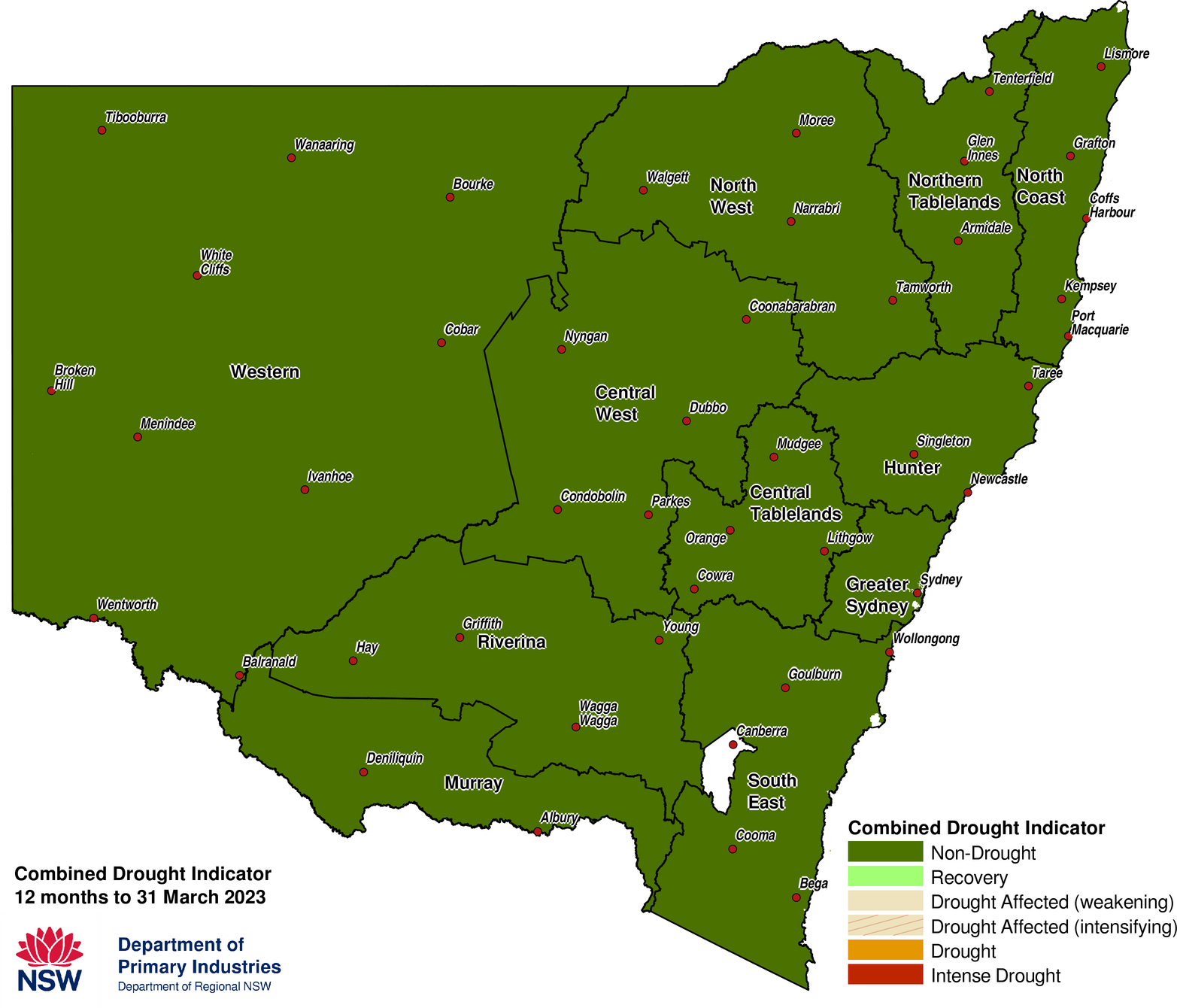
It is important to recognise the CDI provides an aggregated view of NSW, and that on-ground conditions can be different to those displayed in the maps. They provide an ‘on average’ view of a particular region only.
Rainfall
The rainfall anomaly data shows the difference between total monthly rainfall and the long-term average monthly rainfall (1981 – 2010; Figure 2a). Variable rainfall was received across NSW in March. Above average rainfall has been received in northern, central and southern parts of NSW. Average to below average rainfall has been received in parts of Western, North Coast, Sydney and South East LLS regions. The highest negative rainfall anomalies were recorded in the North Coast LLS region. The highest positive rainfall anomalies were recorded around the Young region, and between Tamworth, Narrabri, and Glen Innes across the North West and Northern Tablelands LLS regions.
The highest monthly rainfall totals in March were recorded in the northeast of NSW where rainfall of more than 200mm was received (Figure 2b). Western NSW received less than 25mm of rainfall in March. For the calendar year to date most of coastal NSW has received between 200mm to above 400mm of rainfall. Rainfall west of the Great Dividing Range has totalled between 10mm and 300mm (Figure 2c). Year to date rainfall has been average to below average for most of NSW and slightly above average parts of North West LLS and Murray LLS regions.
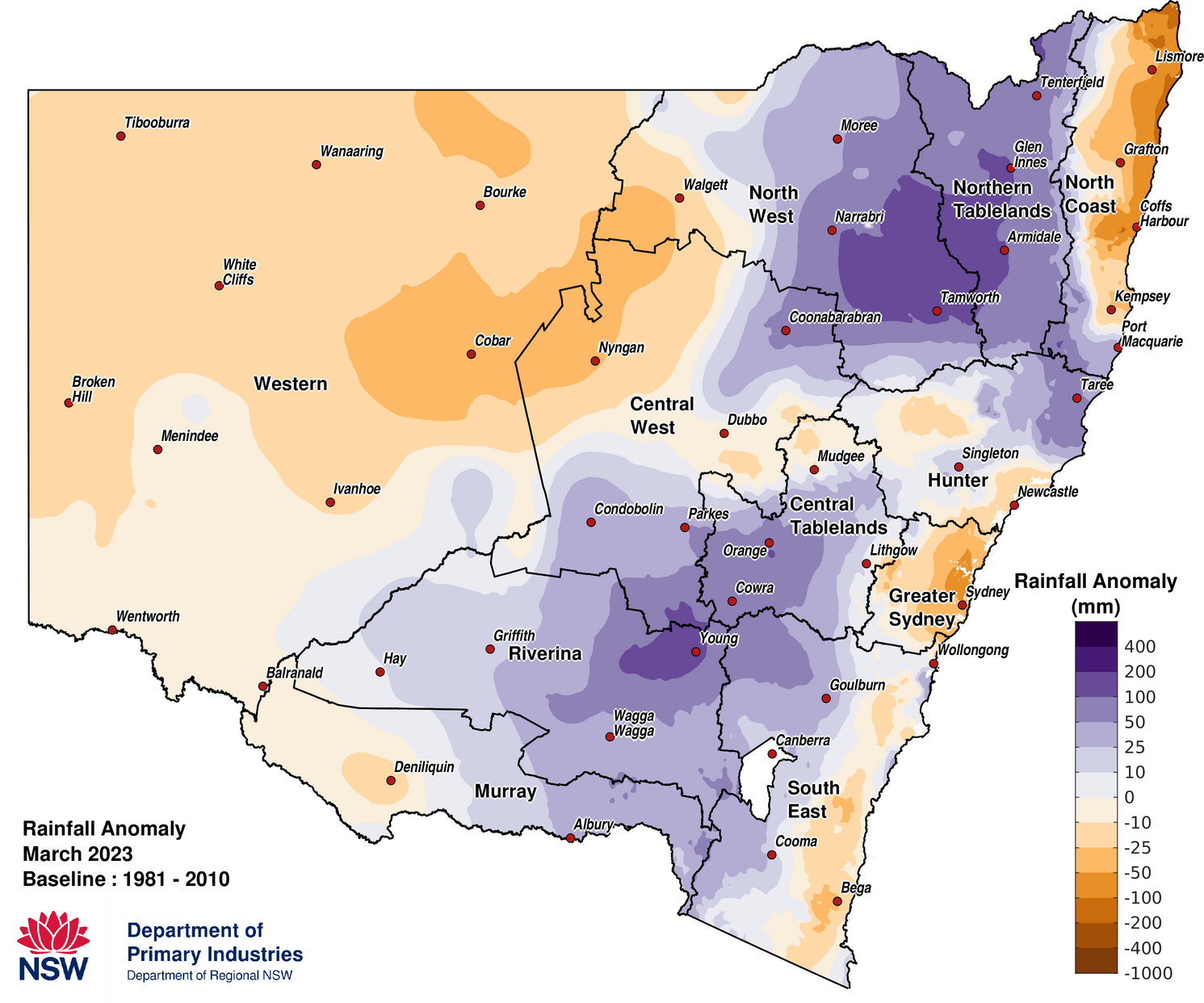
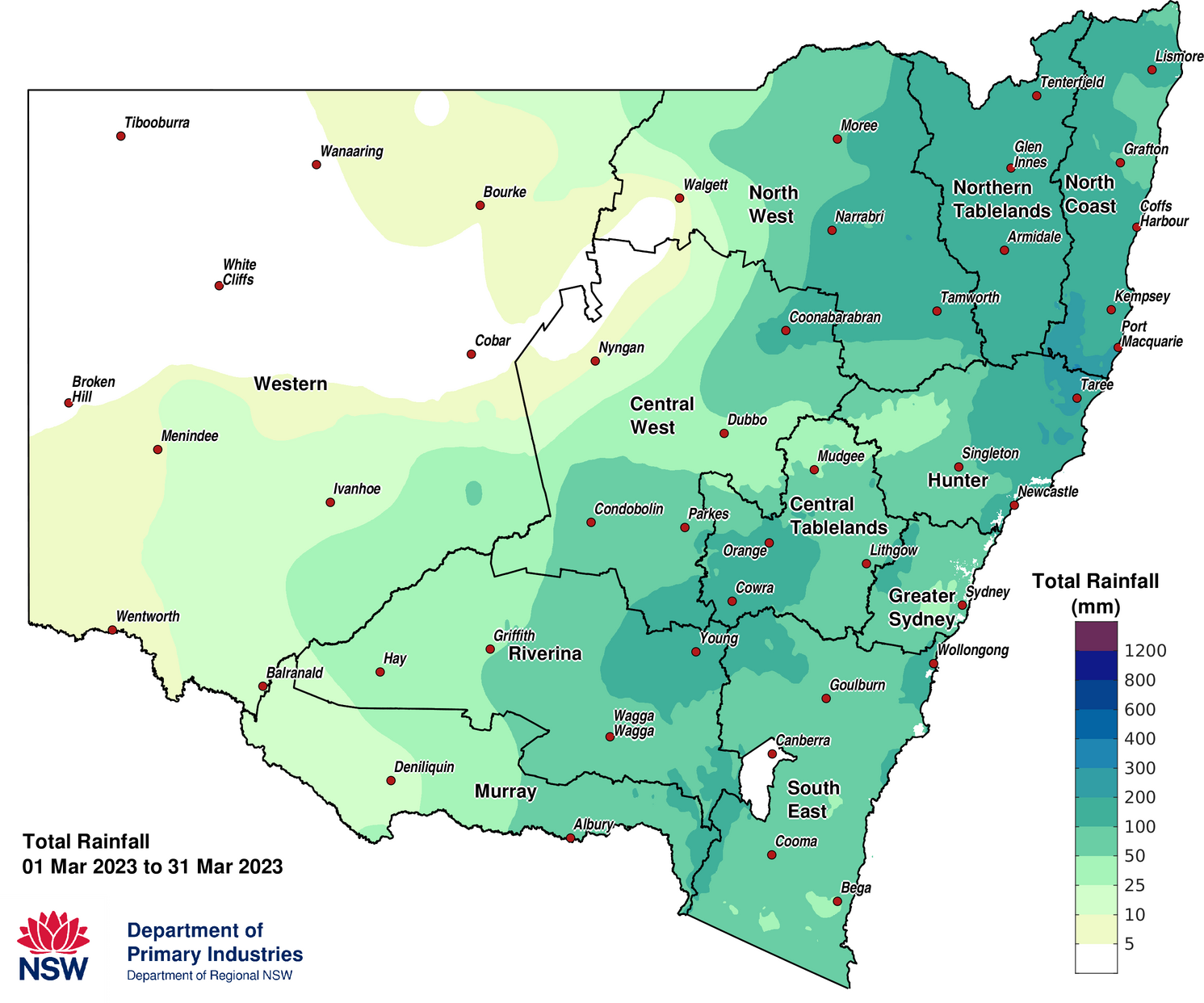
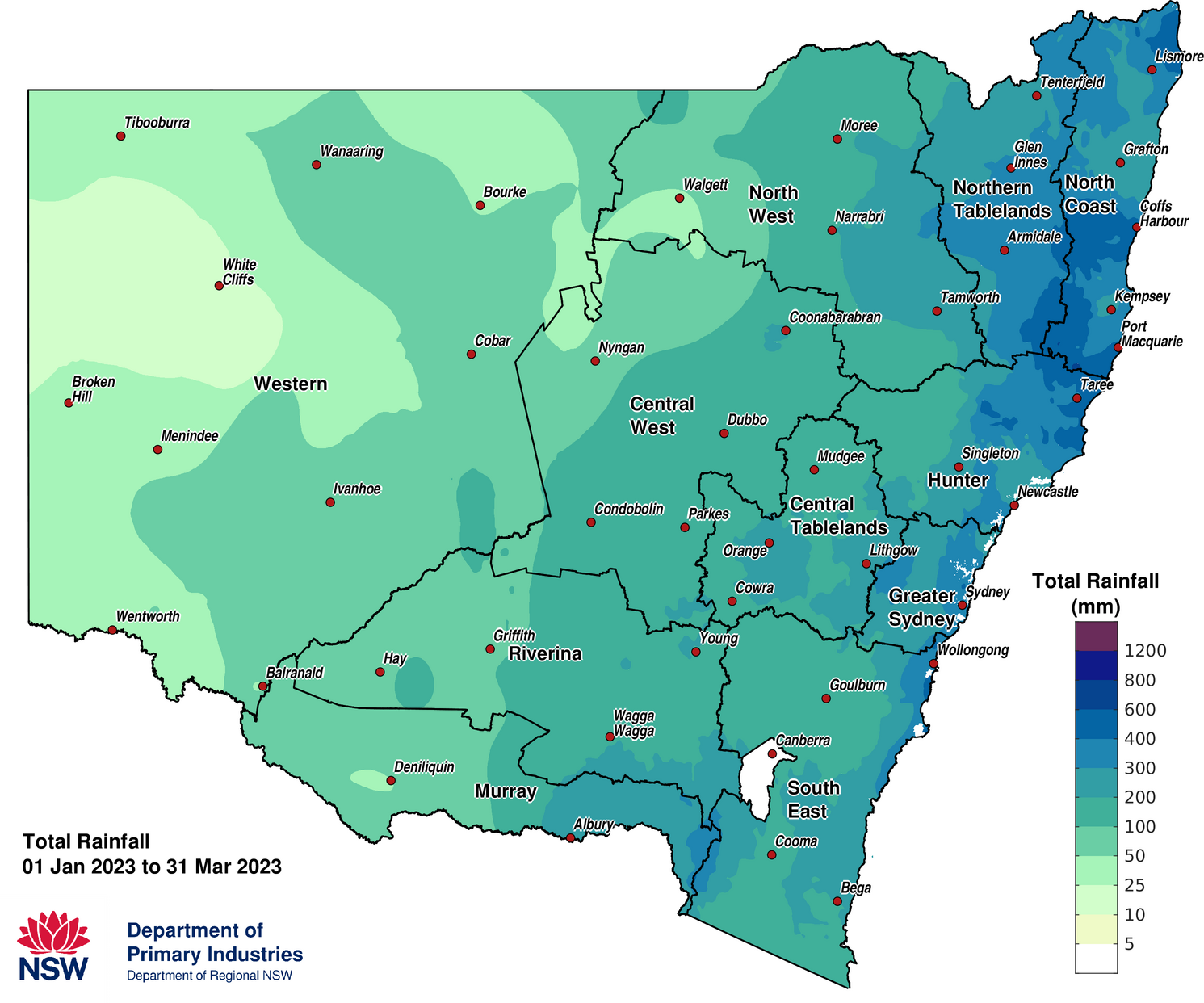
Temperature
Near average maximum temperatures were experienced across southern NSW in March. Maximum temperatures were 1 to more than 3 degrees above average in central and northern NSW, including parts of the North West and Western LLS regions (Figure 3a). In March the average maximum temperatures ranged from 12°C in the southern alps to above 33°C in north-western NSW. Most of NSW experienced day time temperatures above 24°C. Temperatures were generally cooler in the east: parts of the Tablelands and southeast NSW experienced average day time temperatures below 24°C (Figure 3b).
Minimum overnight temperatures were near average for most of NSW in March. Temperatures were 1 to more than 2 degrees above average across parts of northern NSW, particularly north of Moree (Figure 3c). The average February minimum temperatures (Figure 3d) ranged between 3°C to more than 12°C in the alps and Tablelands. The far northwest of NSW recorded the highest average minimum temperatures of above 21°C. Unlike in February when a small number of frost days in the alpine region, there were no frost days for NSW in March (Figure 3e).
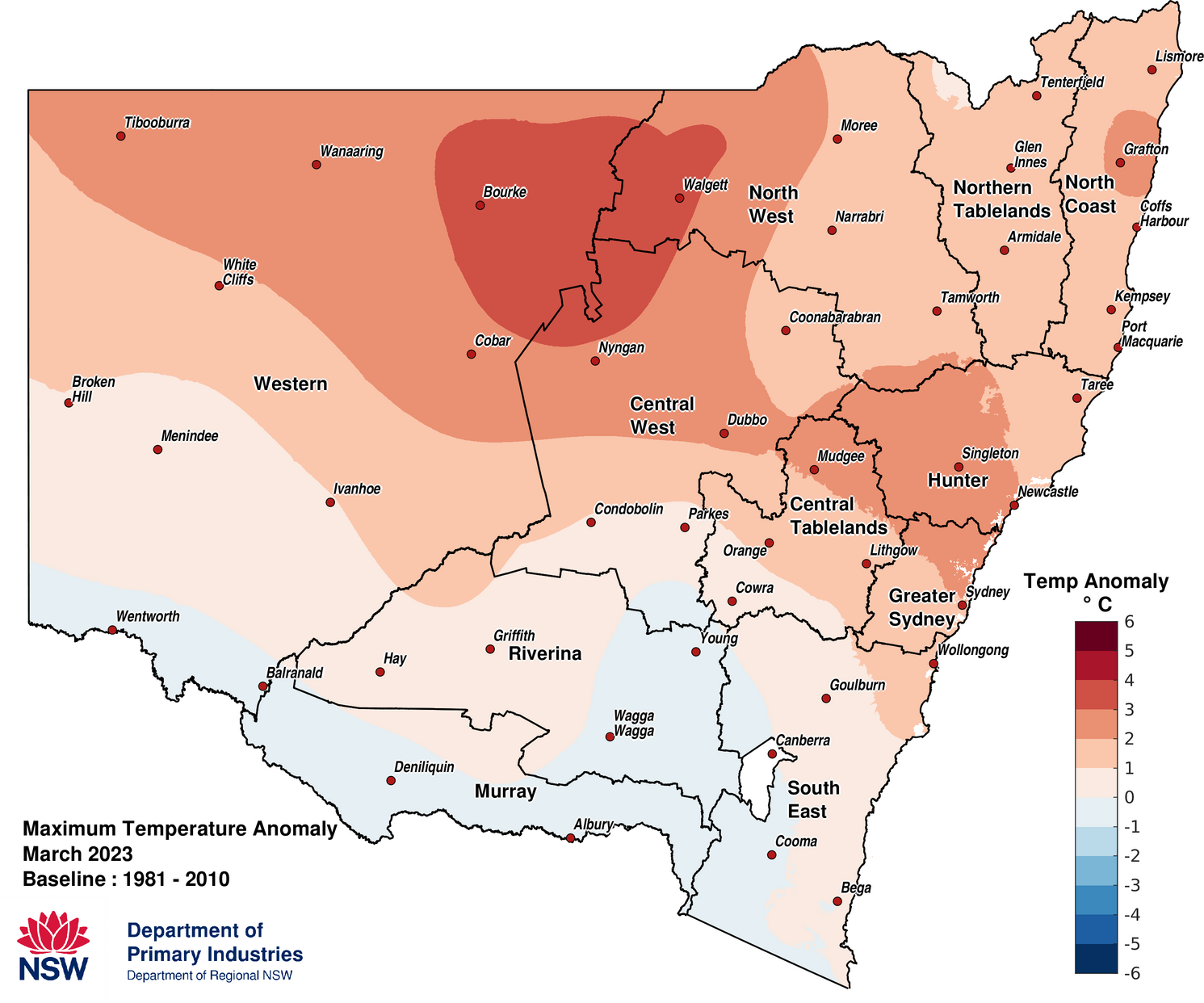
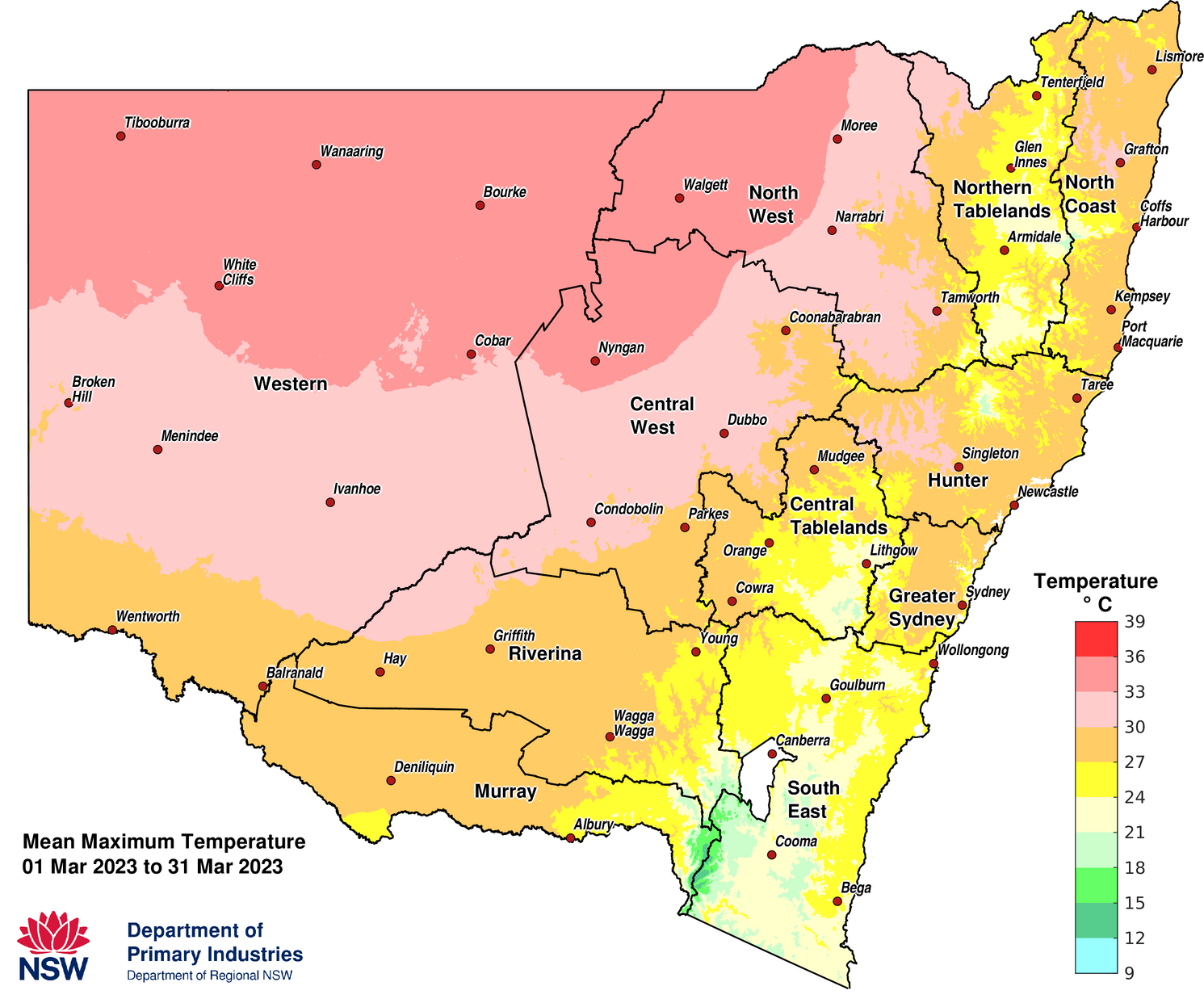
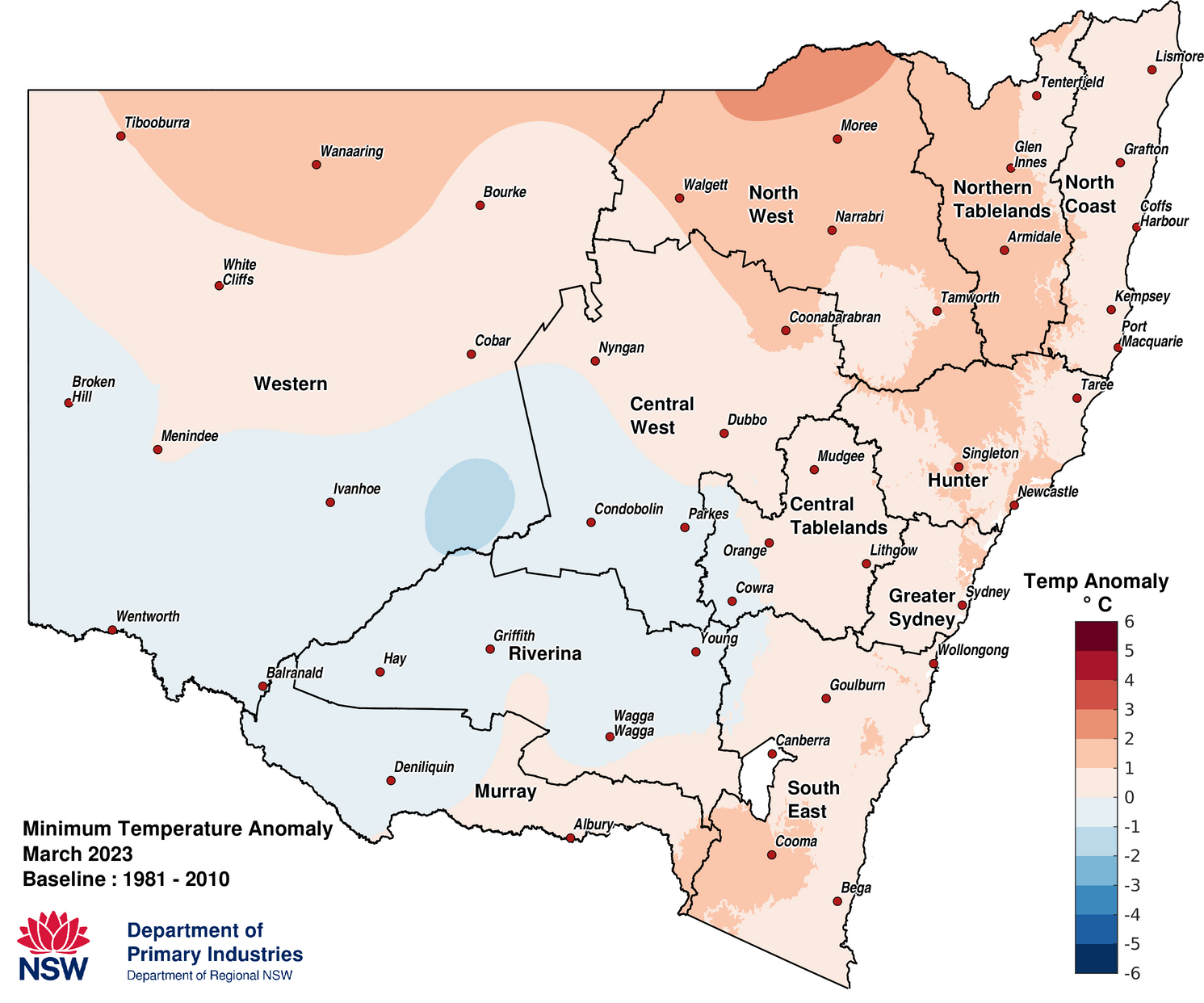
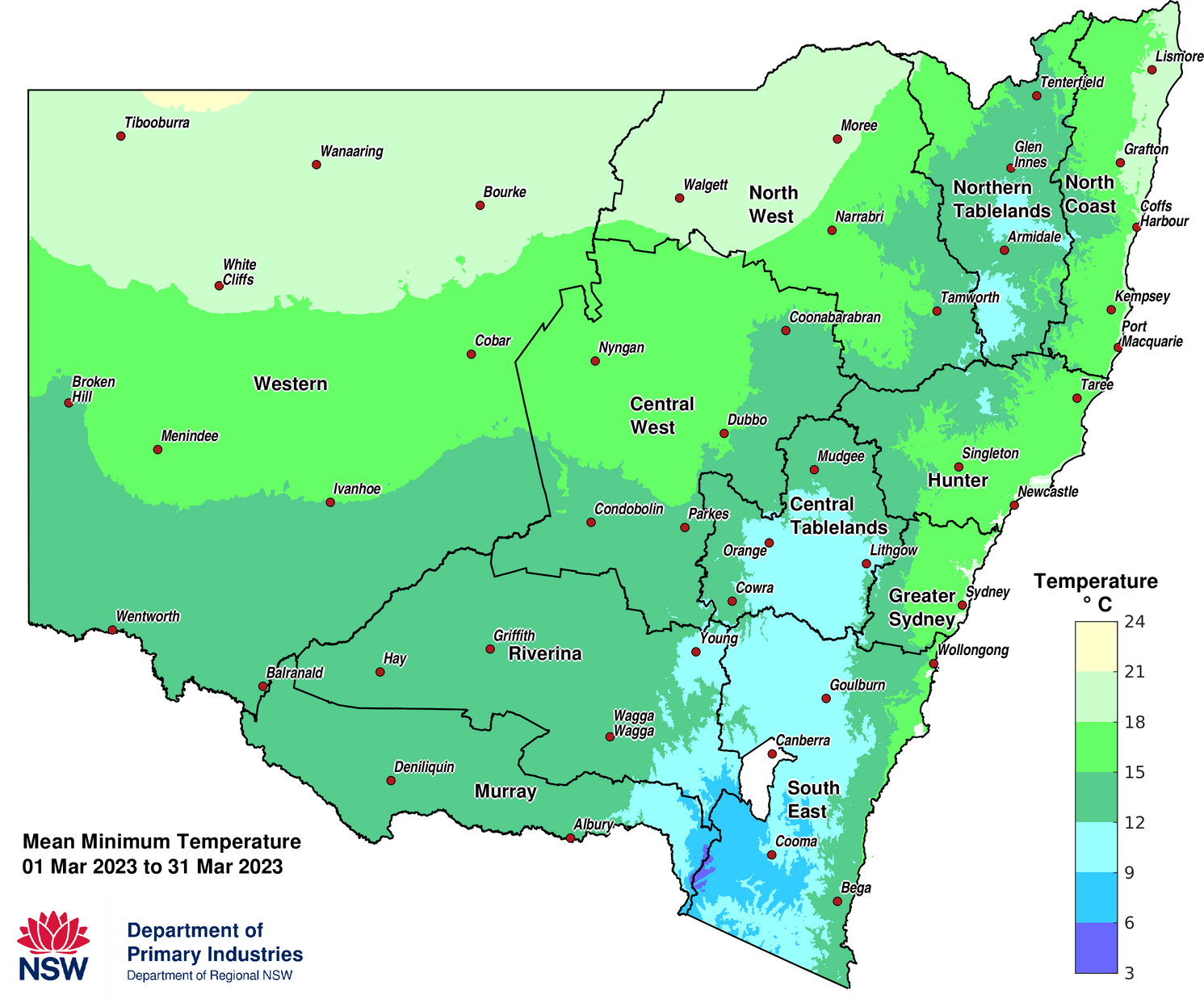
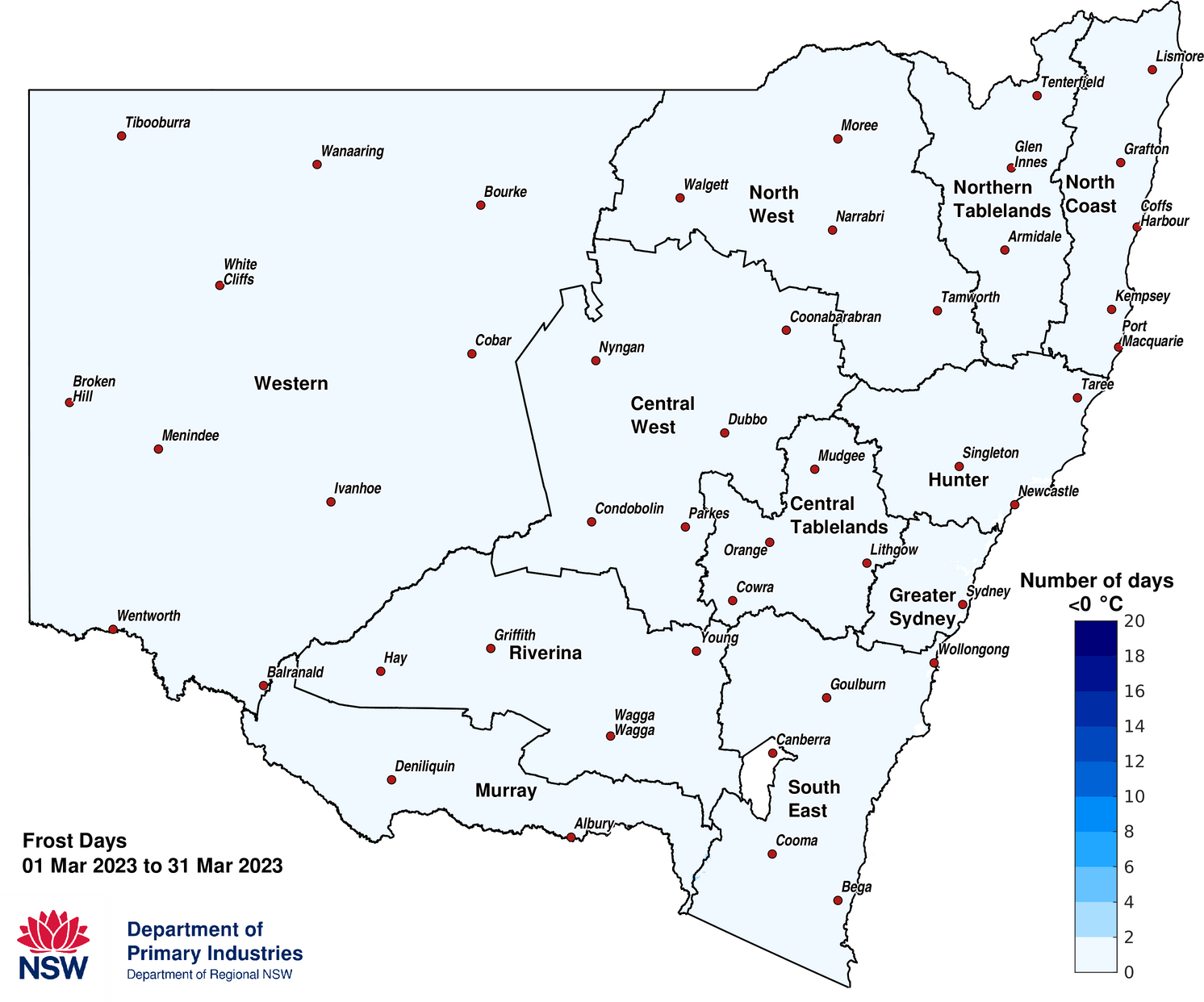
Normalised Difference Vegetation Index (NDVI) Anomaly
The seasonal Normalised Difference Vegetation Index (NDVI, Figure 4) indicates that plant greenness levels are near normal to slightly below normal for central, southern, and eastern areas of NSW. Normal to well above normal plant greenness levels are shown for western areas of NSW for the January to March period. Areas of the Northern Tablelands, North West and Hunter Local Land Services regions have below normal levels of greenness. Some of the extremely negative NDVI areas (brown patches) are water bodies.
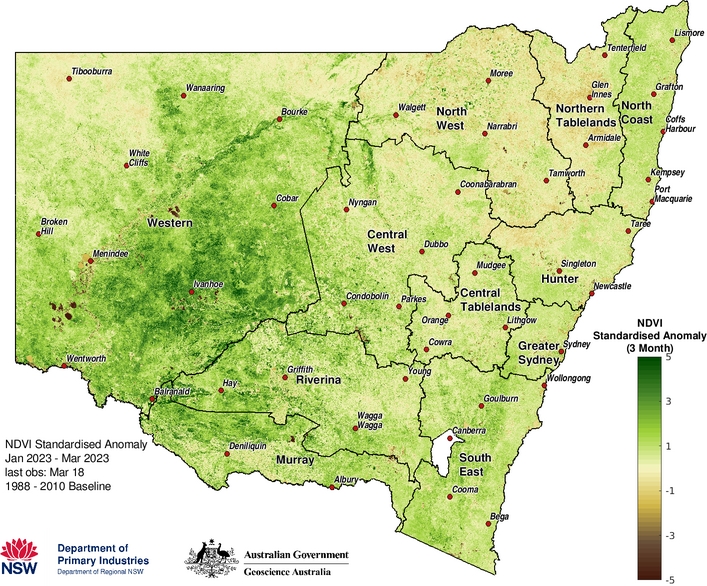
NSW Farm Dam Survey
The NSW Farm Dam Survey indicates dam levels are generally less than 60% of capacity across most of NSW (Figure 5). Areas west of the Great Dividing Range and parts of northern and coastal NSW maintain farm dam levels at less than 20% of capacity. Data is unavailable for some areas of NSW due to cloud cover.
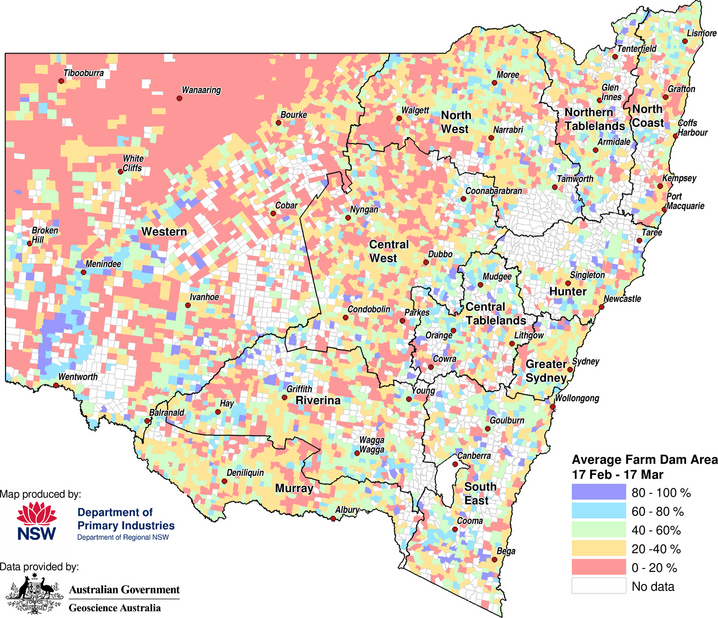
Soil Water Index
The Soil Water Index (SWI, Figure 6) shows that most of NSW is in the extremely high category. However, since the end of February more areas of the North Coast, Northern Tablelands, Hunter, South East and Western LLS regions have moved from the extremely high category to the above average category. Parts of the North Coast and South East LLS regions have moved into the average category. This is due to the low and variable rainfall received in January, February and March.
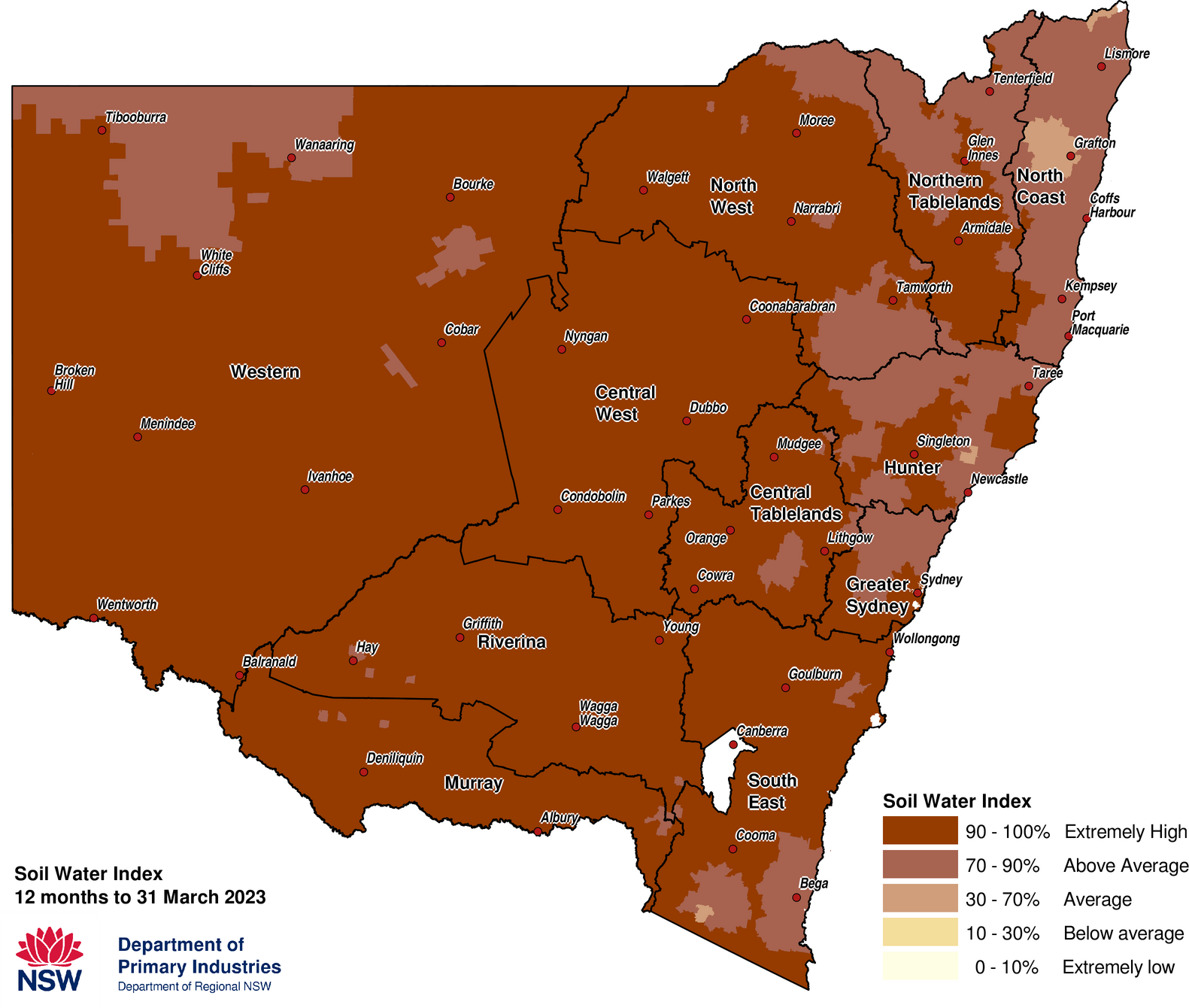
Plant Growth Index
The Plant Growth Index (PGI, Figure 7) shows that most of NSW west of the Great Dividing Range is in the extremely high category at the end of March. Some areas of eastern NSW have moved from the extremely high to the above average category, and from the above average to the average PGI categories in March.
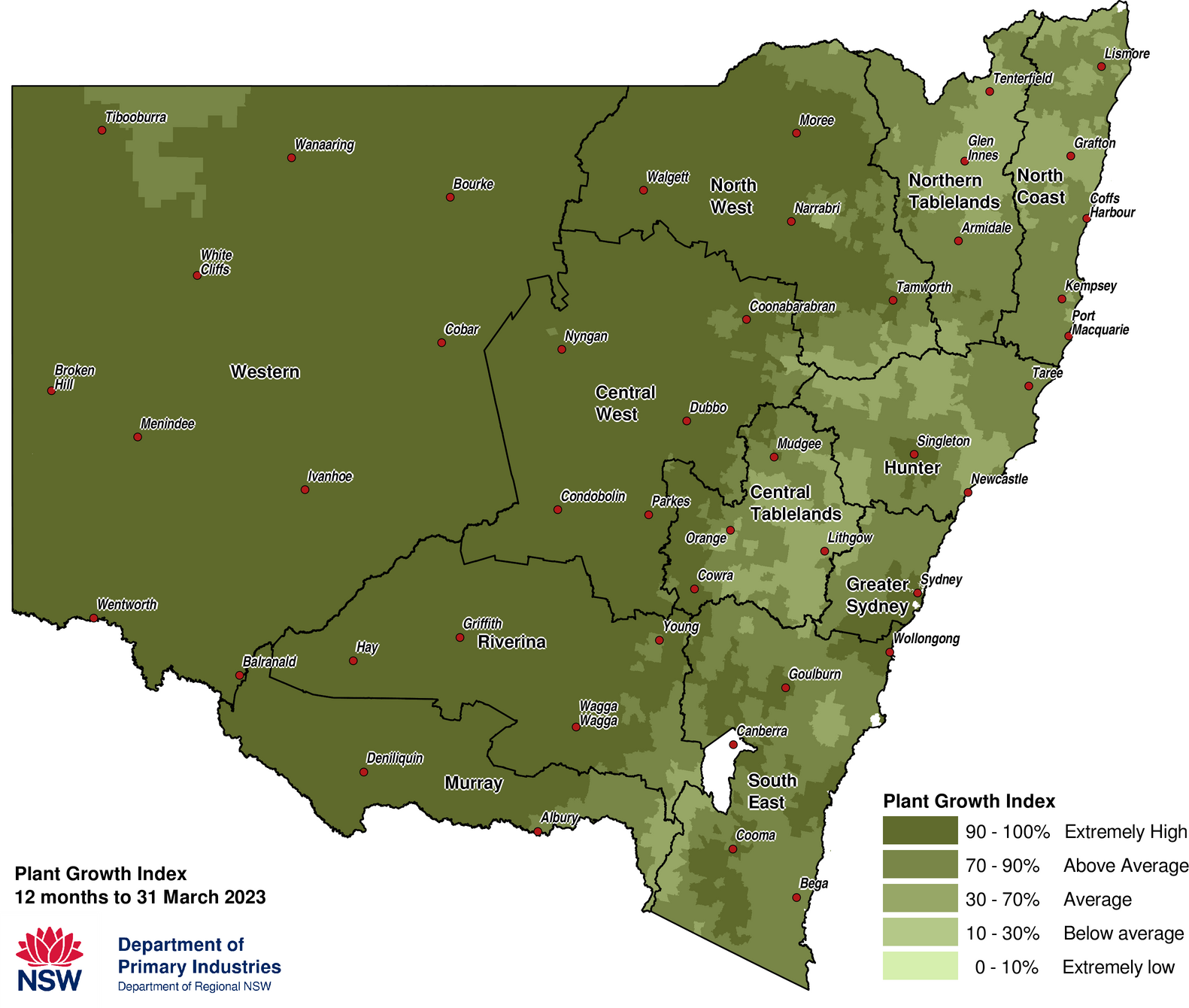
Rainfall Index
The Rainfall Index (RI, Figure 8) for 2023 shows that at the end of March most of NSW is in the extremely high category. Drier December conditions and variable rainfall in the first three month of 2023 have led to parts of northern and eastern NSW moving back into average to above average RI values.
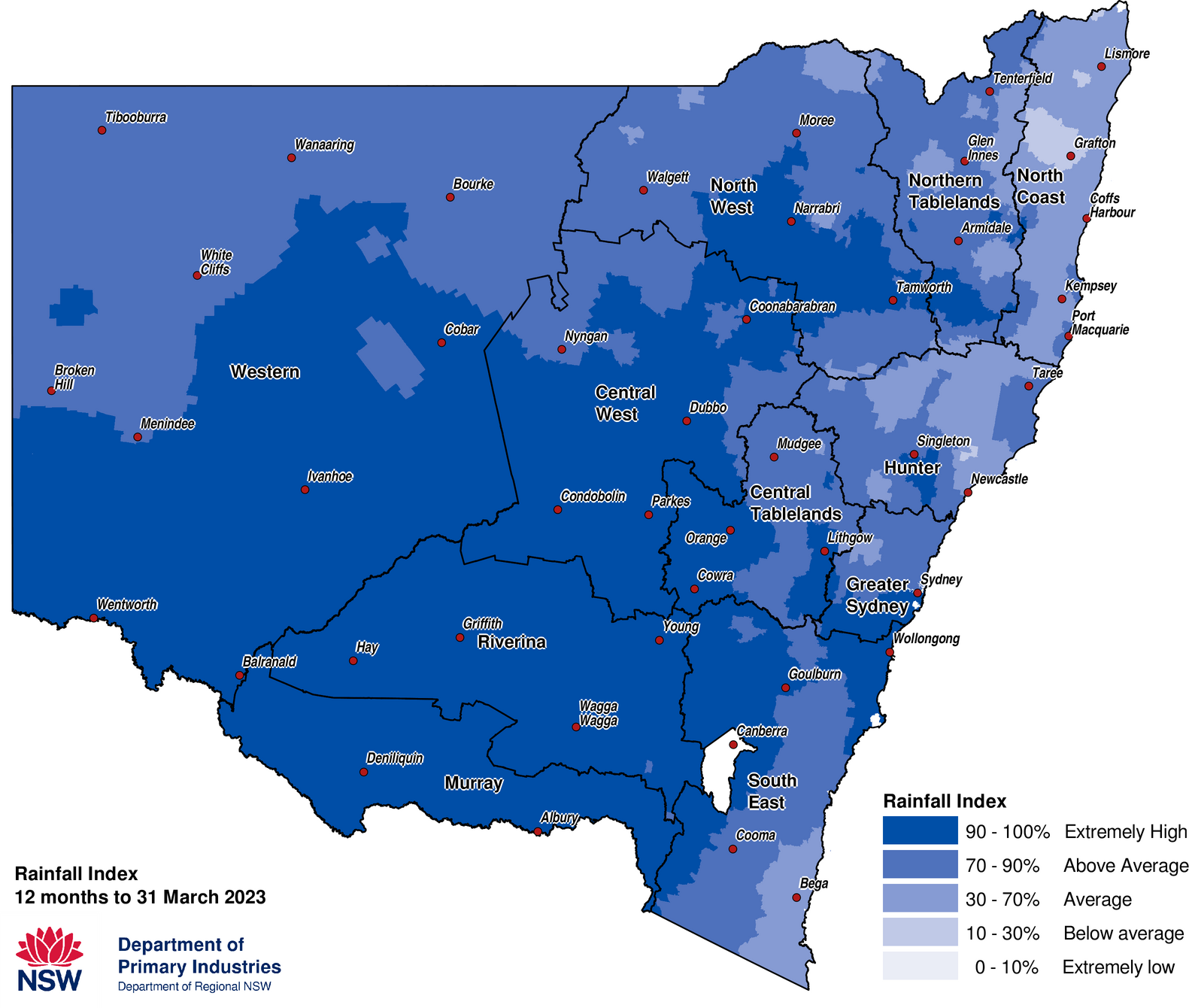
Drought Direction Index
The Drought Direction Index (DDI, Figure 9) tracks the 150-day trend of daily rainfall totals. The DDI shows a strong drying trend throughout most of western NSW and a strong wetting trend in the north-east and along the east coast. Both wetting and drying trends can be seen in parts of eastern NSW. The wetting trends are a result of the higher rainfall amounts received recently from summer storms in February and March. The drying trends are a result of extremely high rainfall recorded in 2022 and the comparatively drier conditions in the few last months. Importantly the weak to strong drying trend does not indicate the emergence of a drought in the regions, rather it indicates a degree of drying following on from the previous very wet conditions.
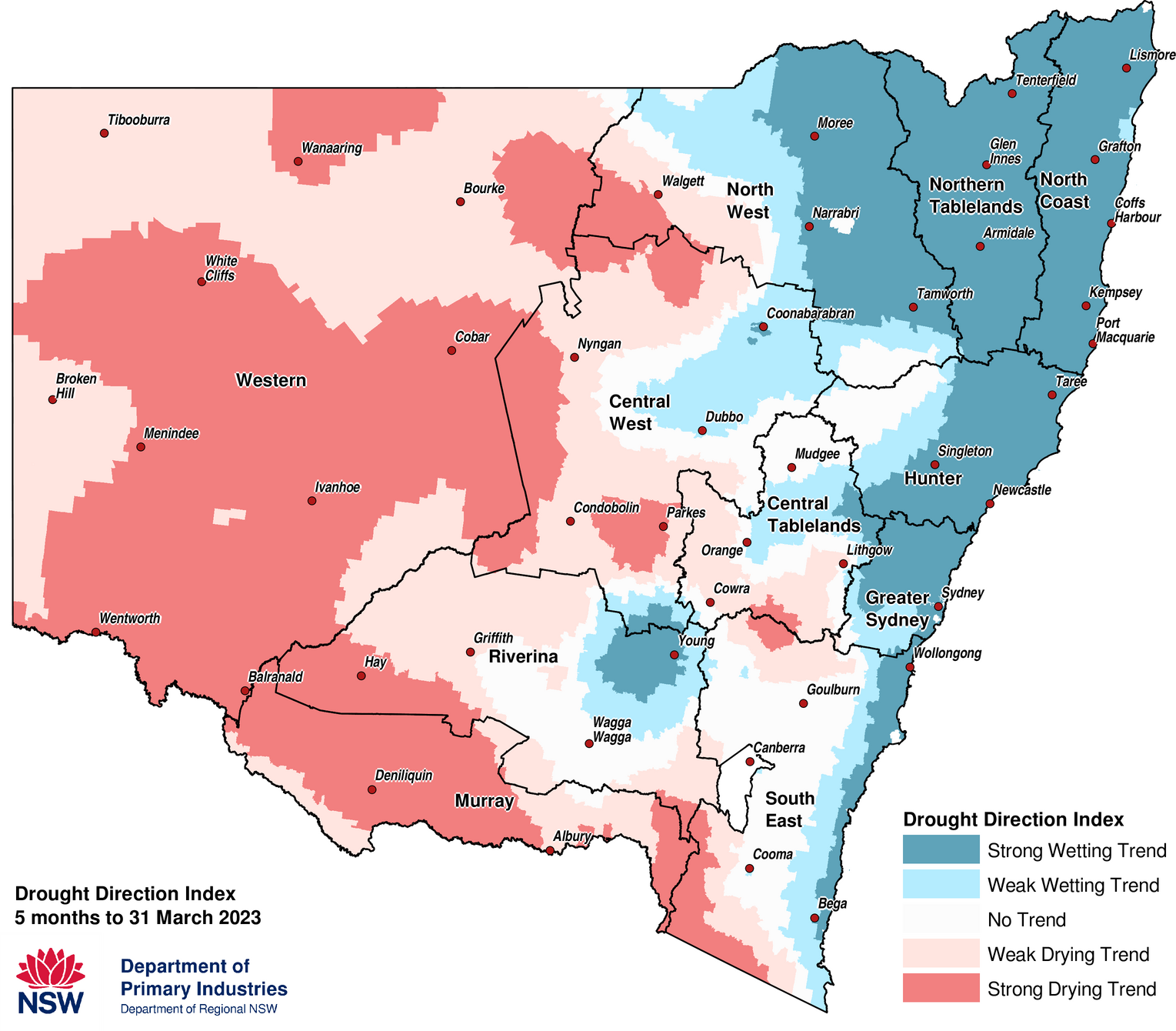
Changes in the individual drought indicators may have occurred since this update was released. For the most current information, please visit DroughtHub.
NSW outlook - April to June
(issued 27 March 2023)
Average rain on the coast, chance of less rain west of the Great Dividing Range
- There is a 60% to greater than 80% chance of below median rainfall west of the Great Dividing Range between April and June.
- Areas east of the ranges have a near equal chance to more than 55% chance of receiving above median rainfall over the 3-month period (Figure 10).
High chance of warmer days for NSW
- The maximum temperature outlook indicates a more than 70% chance of exceeding median daytime temperatures across most of NSW.
- The chance of warmer than median daytime temperatures increases in the west, north, and south-east where there is a greater than 80% chance of above median maximum temperatures (Figure 11).
Warmer nights in east
- There is a 45% to above 80% chance of warmer than median overnight temperatures in eastern NSW during the April to June period (Figure 12).
- West of the Great Dividing Range, there is a near equal to less than 35% chance of above median overnight temperatures.
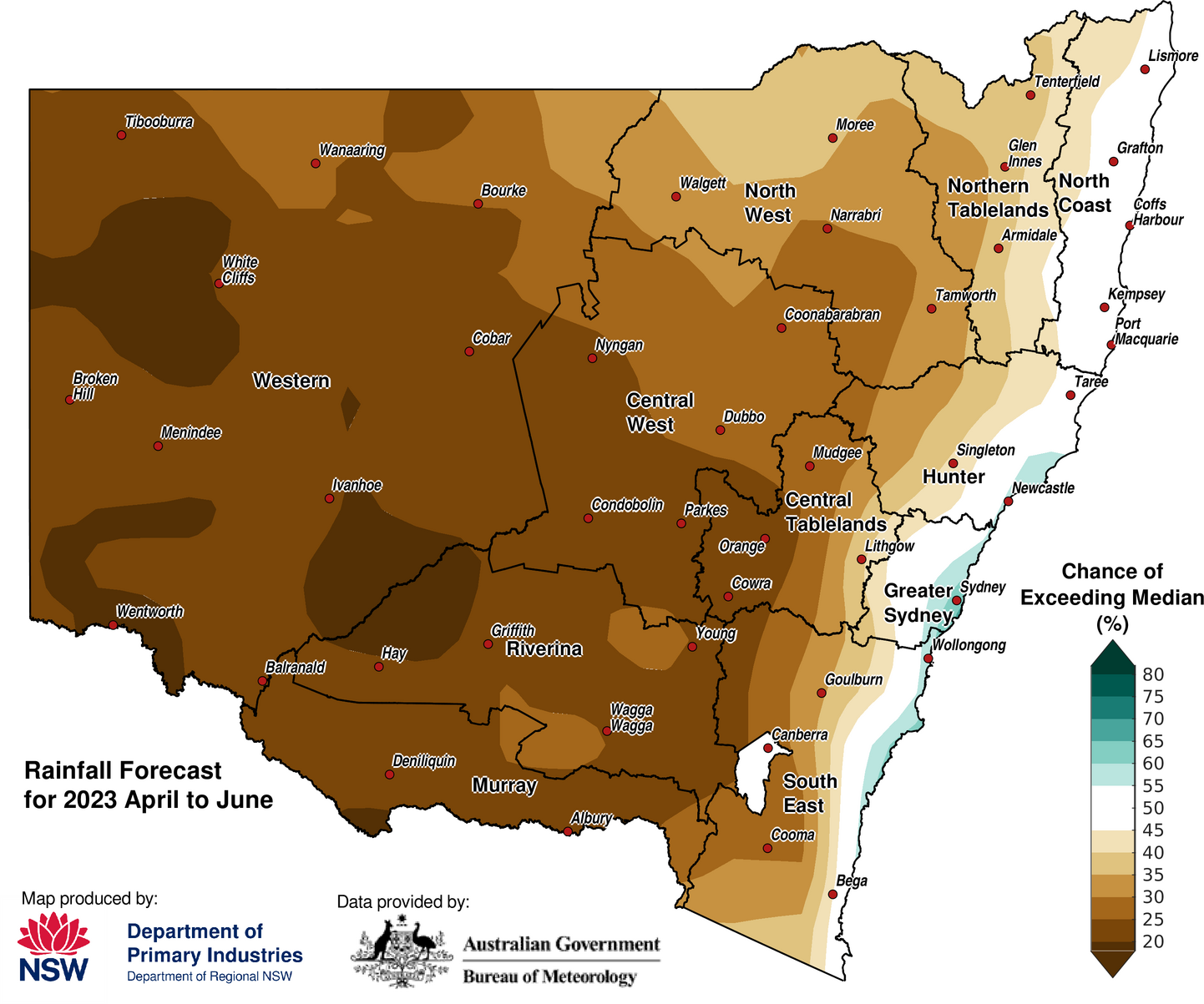
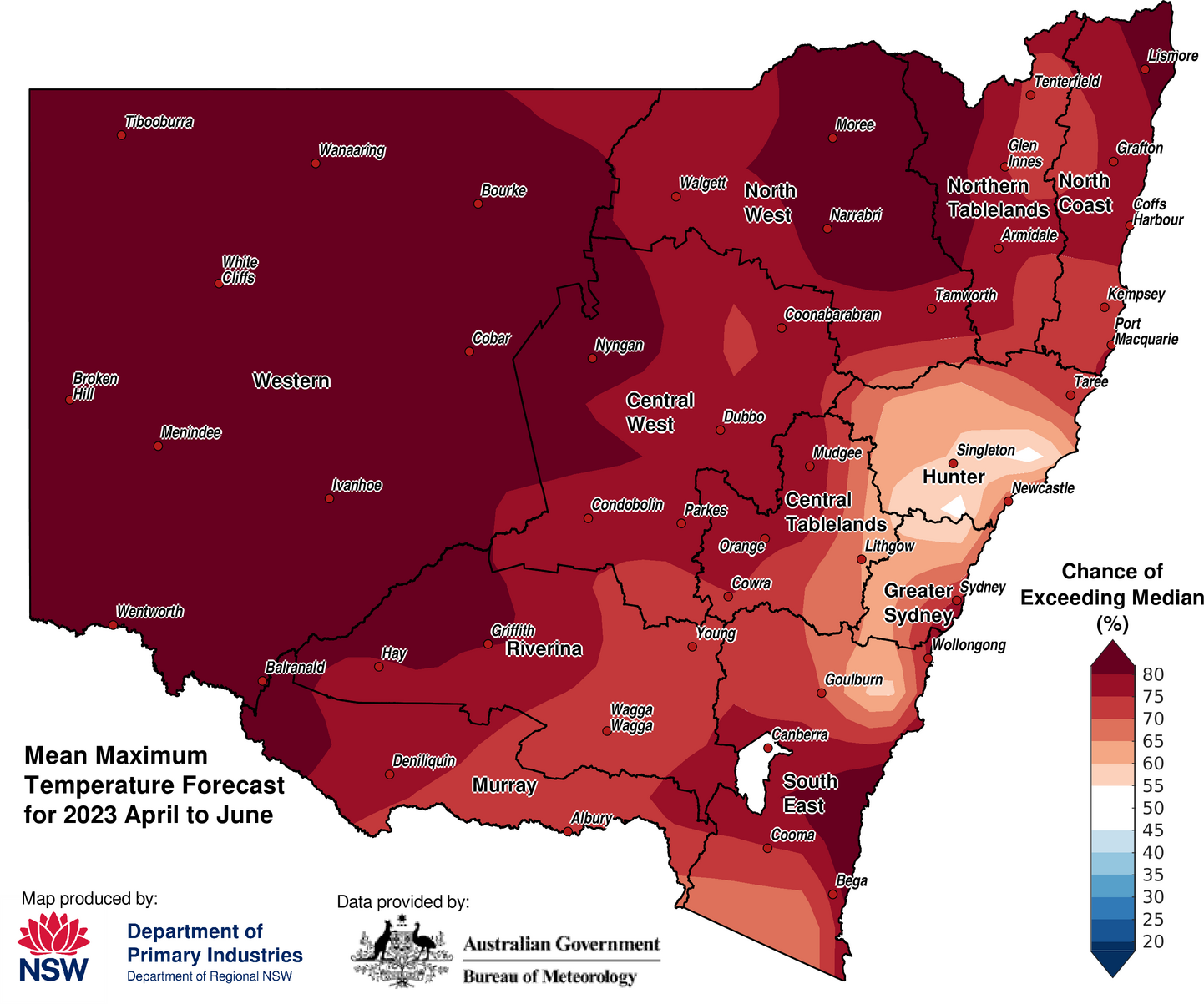
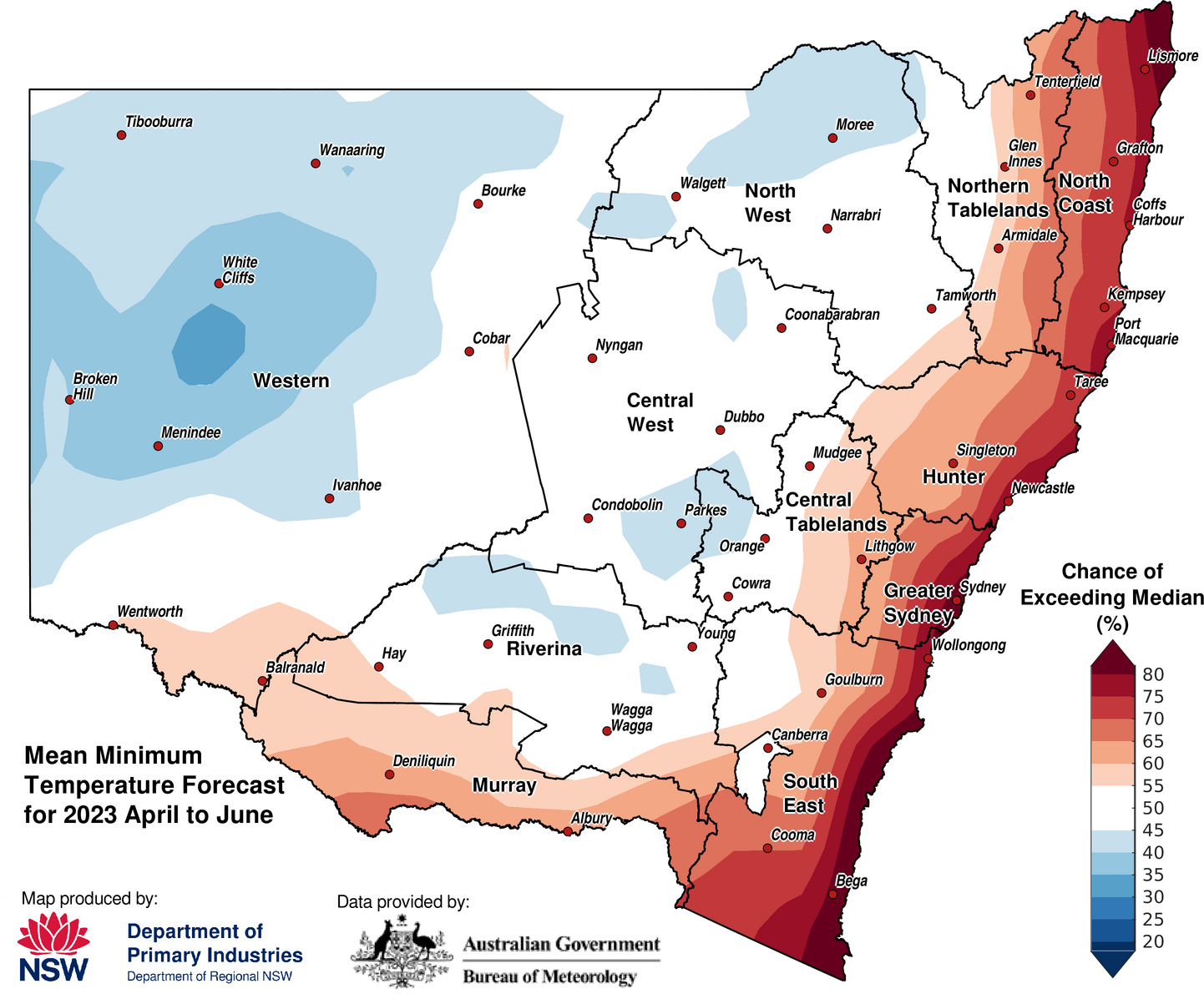
Official national outlook
The official national outlook was released by The Bureau of Meteorology on 30 March 2023. The rainfall outlook for April to June shows that most of Australia has a likely to very likely (60 to more than 80%) chance of below median rainfall. Coastal NSW, south-east Queensland and southern Tasmania have close to equal chances of above or below median rainfall. Forecast accuracy at this time of year has generally been high for eastern, northern and western Australia, with moderate forecast accuracy for southern Australia.
Maximum temperatures from April to June have a likely to very likely (60 to more than 80%) chance of being warmer than average for most of Australia. New South Wales central coast, central to north- eastern Victoria, and areas of north Queensland have an equal chance of above or below average maximum temperatures.
Above median minimum temperatures are likely to very likely (60 to more than 80% chance) for most of Australia for the 3-month period between April to June, except NSW east of the Great Dividing Range, Victoria, Tasmania, and the far south east of South Australia. Areas between western NSW and the Flinders district of South Australia and parts of central Australia have a 60% to 70% chance of below median minimum temperatures.
The Bureau issues a new 3-month seasonal update weekly, each Thursday afternoon.
Global climate drivers
El Niño–Southern Oscillation (ENSO)
The Bureau of Meteorology’s El Niño-Southern Oscillation (ENSO) Outlook was released on 28 March 2023. The ENSO Outlook status is currently neutral. Sea surface temperatures (SSTs) and atmospheric ENSO indicators in the tropical Pacific Ocean are now at ENSO-neutral conditions. Climate models suggest SSTs will remain at neutral ENSO conditions during autumn.
Long range forecasts suggest that El Niño may form later in the year however long range ENSO predictions made in autumn have lower accuracy than ENSO predictions made in winter or spring. The Bureau of Meteorology has issued an El Niño WATCH, indicating a 50% chance of El Niño occurring in 2023.
Southern Oscillation Index
The 30-day Southern Oscillation Index (SOI; Figure 13) for the 30 days ending 26 March was +0.9. The 90-day SOI value was +9.0. Sustained negative values of the SOI below −7 typically indicate El Niño while sustained positive values above +7 typically indicate La Niña.
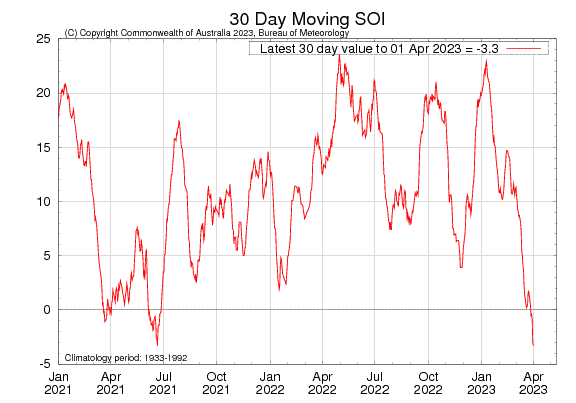
Sea surface temperatures (SST)
Sea surface temperatures (SST) were close to average along the equator in the central tropical Pacific Ocean. Weak warm anomalies were observed around the Maritime Continent to the north of Australia, south-west Western Australia, and from south-east NSW to New Zealand and southern Tasmania (Figure 14).
The latest values of the three NINO indices in the tropical Pacific for the week ending 26 March were: NINO3 +0.5 °C, NINO3.4 +0.1 °C, NINO4 0.0 °C.
Persistent NINO3 or NINO3.4 values warmer than +0.8 °C are typical of El Niño, while persistent values cooler than −0.8 °C typically indicate La Niña.
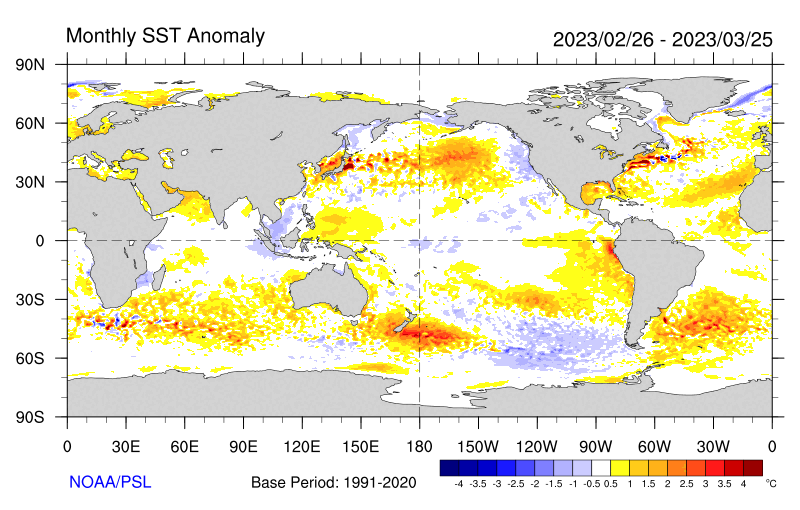
Sea sub-surface temperatures
The four-month sequence of equatorial Pacific sub-surface temperature anomalies (to 23 March 2023) shows weak cool anomalies to 150m depth have decreased in strength and contracted to a small area in the eastern equatorial Pacific Ocean (Figure 15). Warm anomalies, of more than 3oC above average, have expanded eastward and are present west of 160oW for most of the depth shown in the western Pacific and from 100m to 200m depth in the central Pacific.
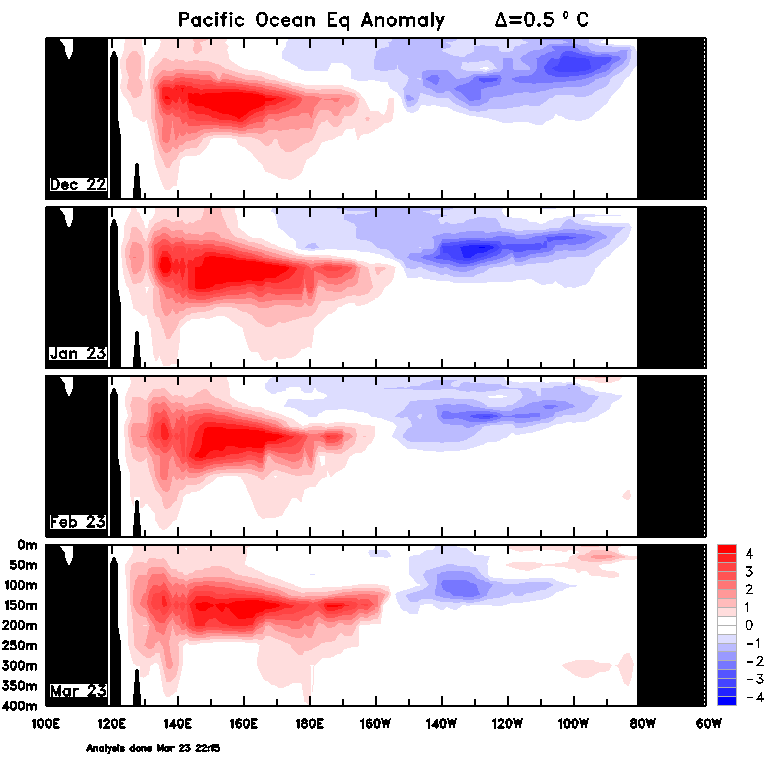
Indian Ocean (IOD)
The Indian Ocean Dipole (IOD) is currently neutral. Whilst the monsoon trough is in the southern hemisphere from December to April, the IOD has little influence on Australia’s climate. The latest weekly value of the Indian Ocean Dipole (IOD) index to 26 March 2023 was +0.36 °C.
Most of the international climate models surveyed by the Bureau of Meteorology suggest a positive IOD may emerge in late autumn or winter. However, IOD forecasts made through autumn historically have very low accuracy. A positive IOD occurs at values greater than +0.4 °C and can suppress winter and spring rainfall over much of Australia, including NSW.
Southern Ocean (Southern Annular Mode – SAM)
The Southern Annular Mode (SAM) index is neutral (as of 01 April) and is expected to remain neutral during April (Figure 16). A neutral SAM has little influence on Australia’s rainfall and temperature.
The Southern Annular Mode (SAM) refers to the north-south shift of rain-bearing westerly winds and weather systems in the Southern Ocean compared to their usual position. This indicator can be quite volatile and generally influences weather conditions on 1 to 3 week timescales.
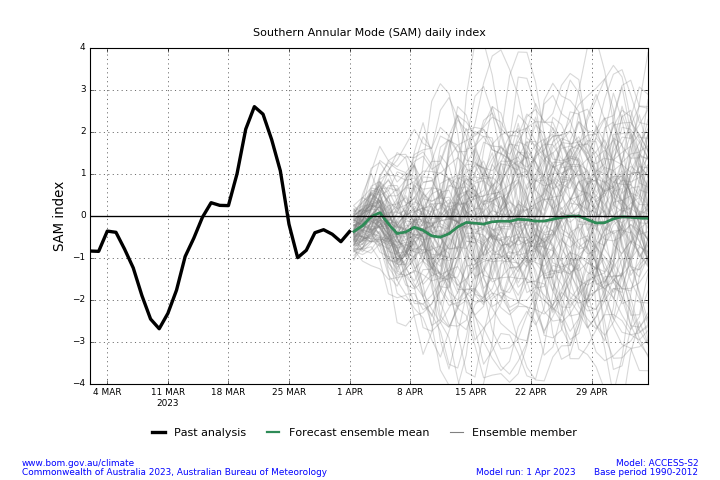
CDI status for the regions
Figure 17 displays the CDI status for each individual Local Land Services (LLS) region to 31 March 2023. The following regional descriptions are based on data available until the end of March 2023.
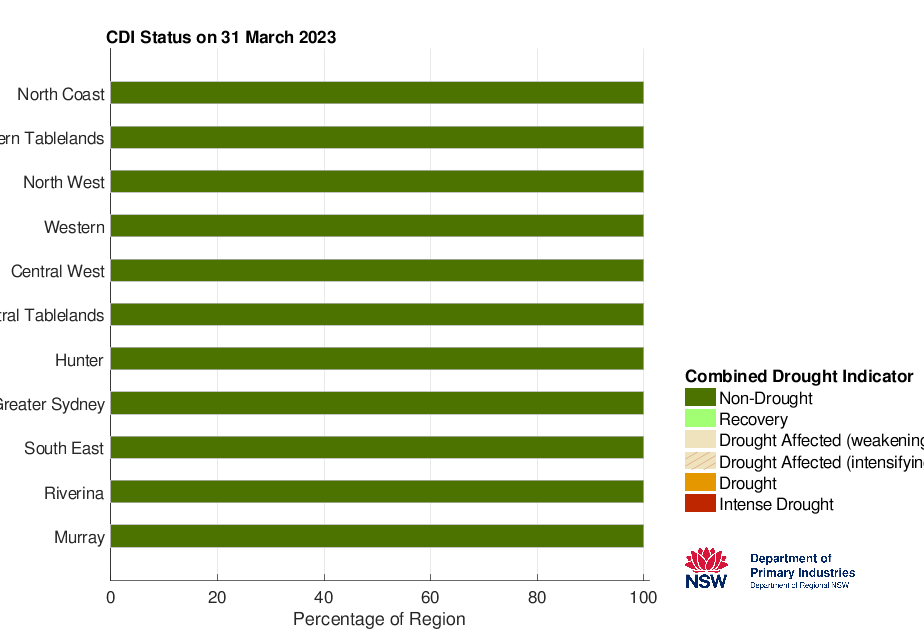
Murray and Riverina regions
The Combined Drought Indicator (CDI, Figure 18) shows that all of the Riverina and Murray Local Land Services (LLS) regions remain in the Non-Drought category at the end of March.
The seasonal NDVI anomaly data (Figure 19) shows that parts of the Murray and Riverina regions, particularly in the west, were experiencing higher than normal plant greenness levels for the January to March period. Average levels of greenness are more predominant in the parts of the northern and eastern Riverina region. Some of the extremely negative NDVI areas (brown patches) represent water.
There were on ground reports of flash flooding in the Cootamundra region during March. There are also reports that planning for autumn forage crops is underway on the south west slopes and across the Riverina after recent rainfalls.
The Drought History charts (Figure 20) show the individual response of the drought indicators for Hay, Temora, Finley, and Moulamein. The indicators are high at all locations and suggest a strong production outlook. To access a Drought History chart for your Parish, visit the Seasonal Conditions Information Portal.
The Combined Drought Indicator (CDI) is a tool that monitors drought conditions across NSW. The drought categories are based on assessing the response of three drought indicators: soil water, plant growth and rainfall. The indicators track the data over the past 12 months and show how the indices are tracking compared to long-term averages. The information provided in the map is aggregated to a Parish level and provides a regional assessment of conditions. Variability within and between farms is possible and this may not be reflected in the CDI map.
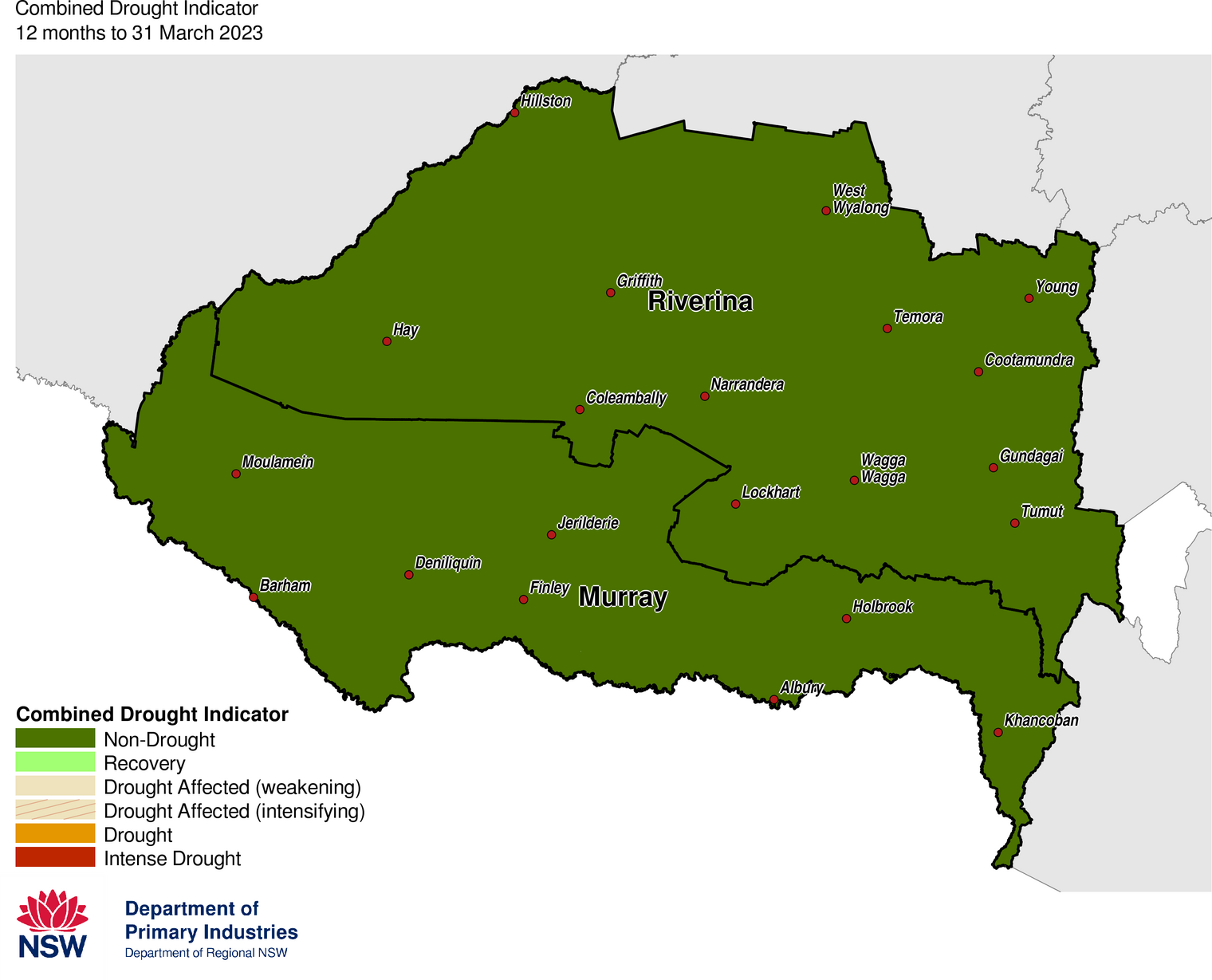
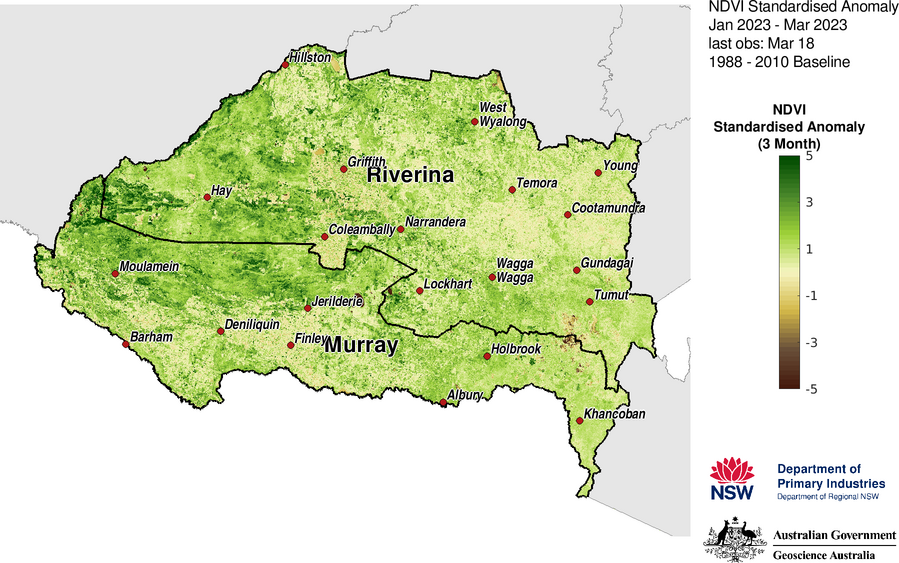
![]()
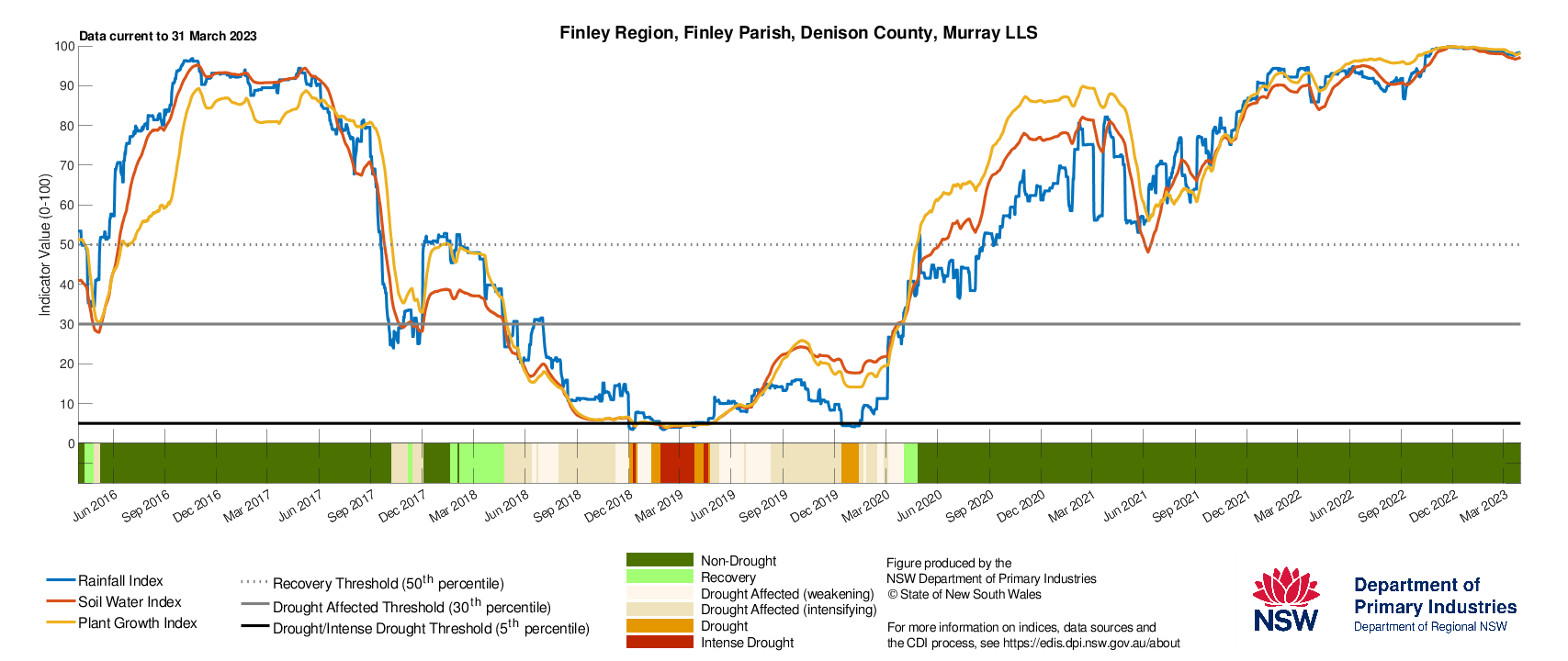
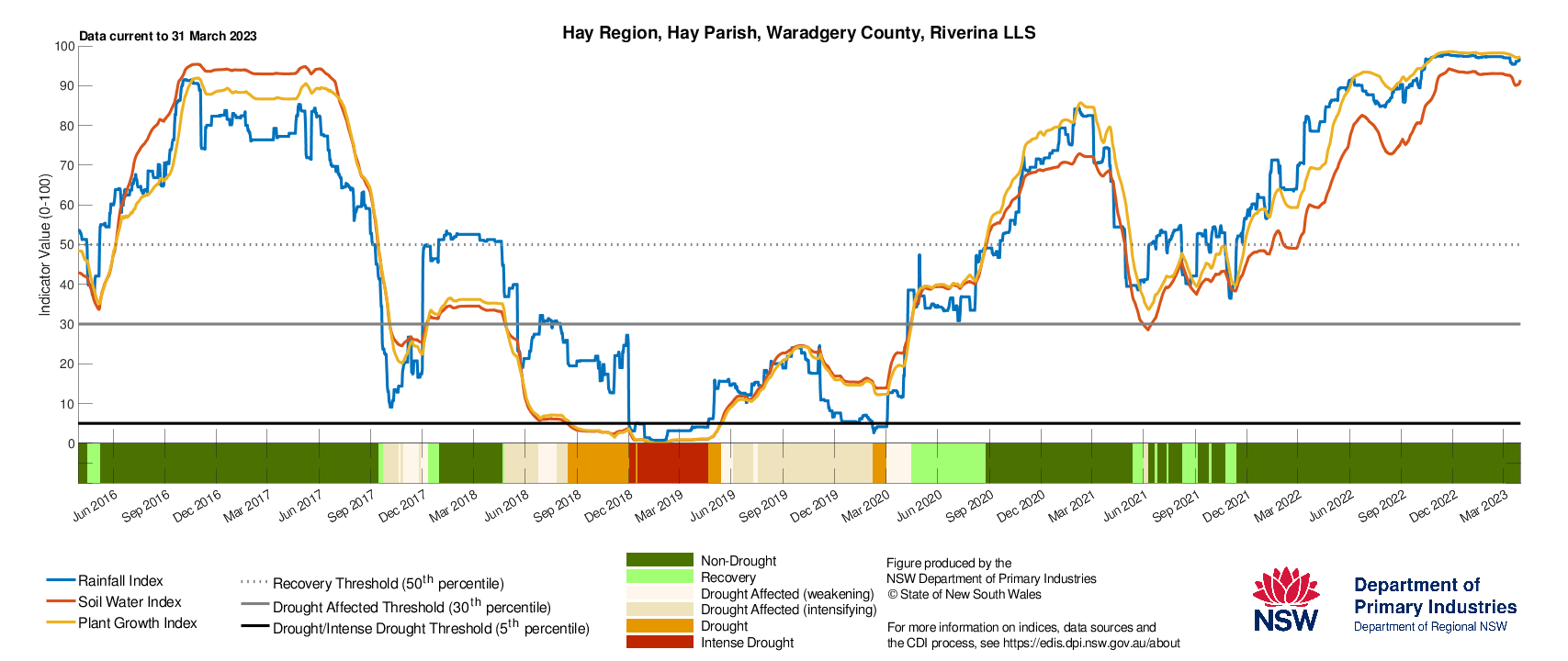
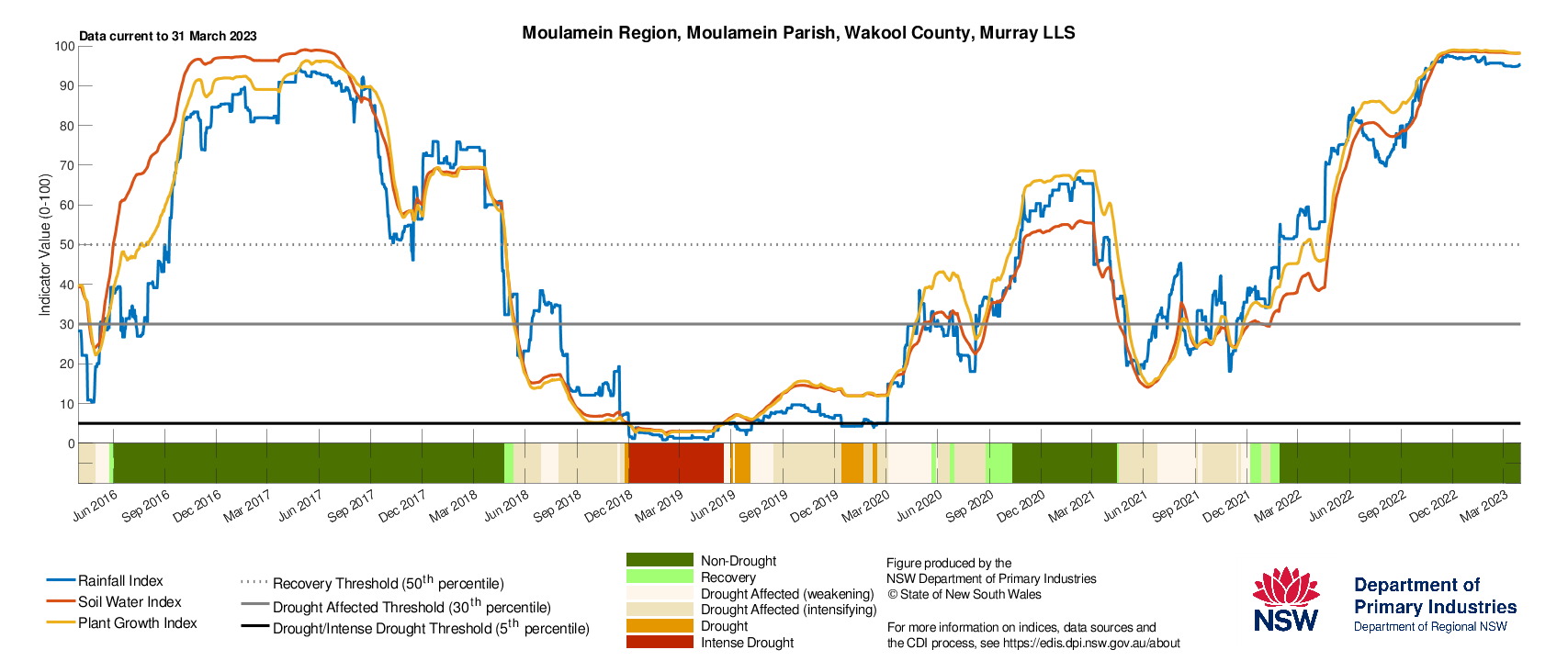
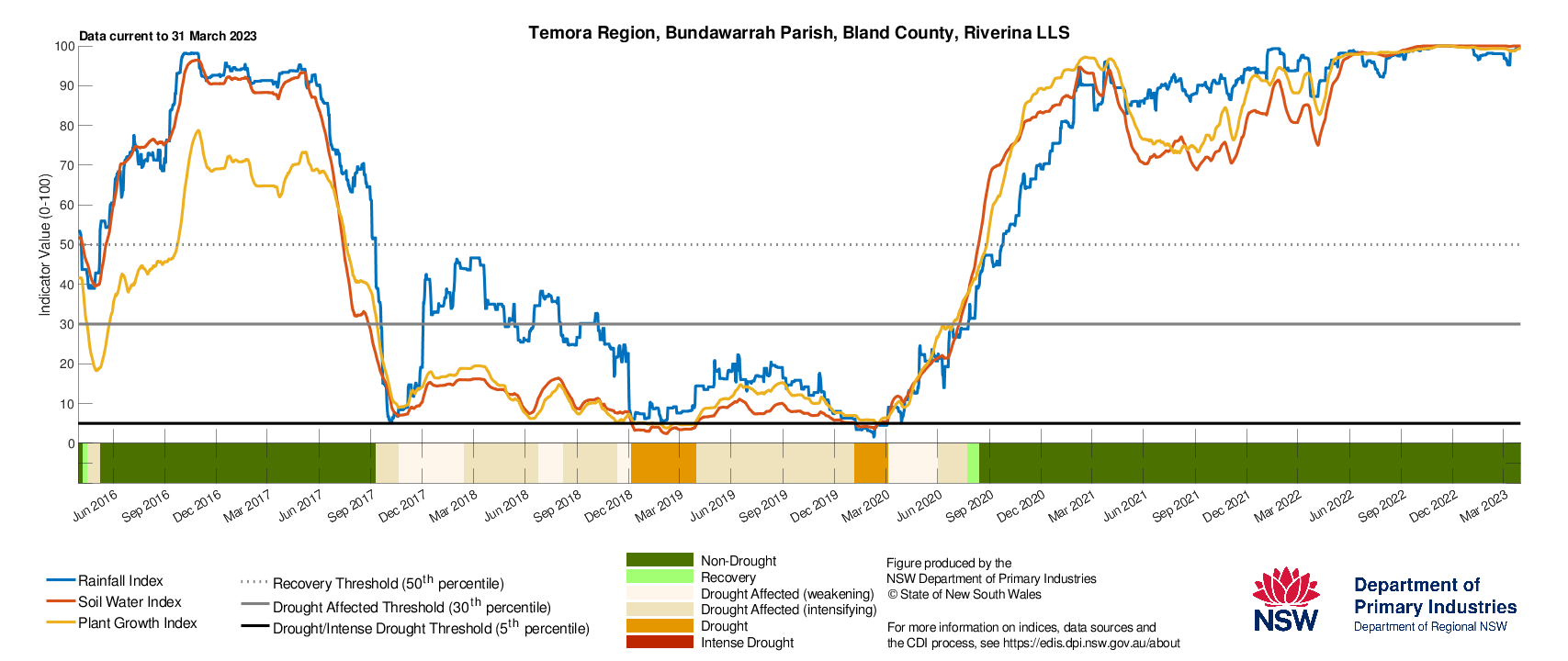
Western region
The Combined Drought Indicator (CDI, Figure 21) shows that the Western LLS region is currently in the Non-Drought category. In mid-March fish kills occurred on the lower Darling-Baaka River near Menindee, due to receding flood waters and higher water temperatures.
March rainfall was below average for the Western region and some parts have low farm dam levels. Other areas are experiencing high to very high farm dam levels due to flooding in 2022. The DPI continues to closely monitor conditions in Western LLS.
The seasonal NDVI anomaly data (Figure 22) shows normal to very high levels of plant greenness across most of the Western LLS region for the January to March period. Lower levels of greenness are apparent in the far north-west. Some of the extremely negative NDVI areas (brown patches) represent water.
The Drought History charts (Figure 23) show the individual response of the drought indicators for Bourke, Ivanhoe, Wentworth, and Broken Hill. Although still high, the rainfall indicator has declined at Bourke and Broken Hill, with smaller declines also visible in the soil water and plant growth indicators. Indicators remain high at Ivanhoe and Wentworth. To access a Drought History chart for your Parish, visit the Seasonal Conditions Information Portal.
The Combined Drought Indicator (CDI) is a tool that monitors drought conditions across NSW. The drought categories are based on assessing the response of three drought indicators: soil water, plant growth and rainfall. The indicators track the data over the past 12 months. This shows how the indices are tracking compared to the long-term averages. The information provided in the map is aggregated to a Parish level and provides a regional assessment of conditions. Variability within and between farms is possible and this may not be reflected in the CDI map.
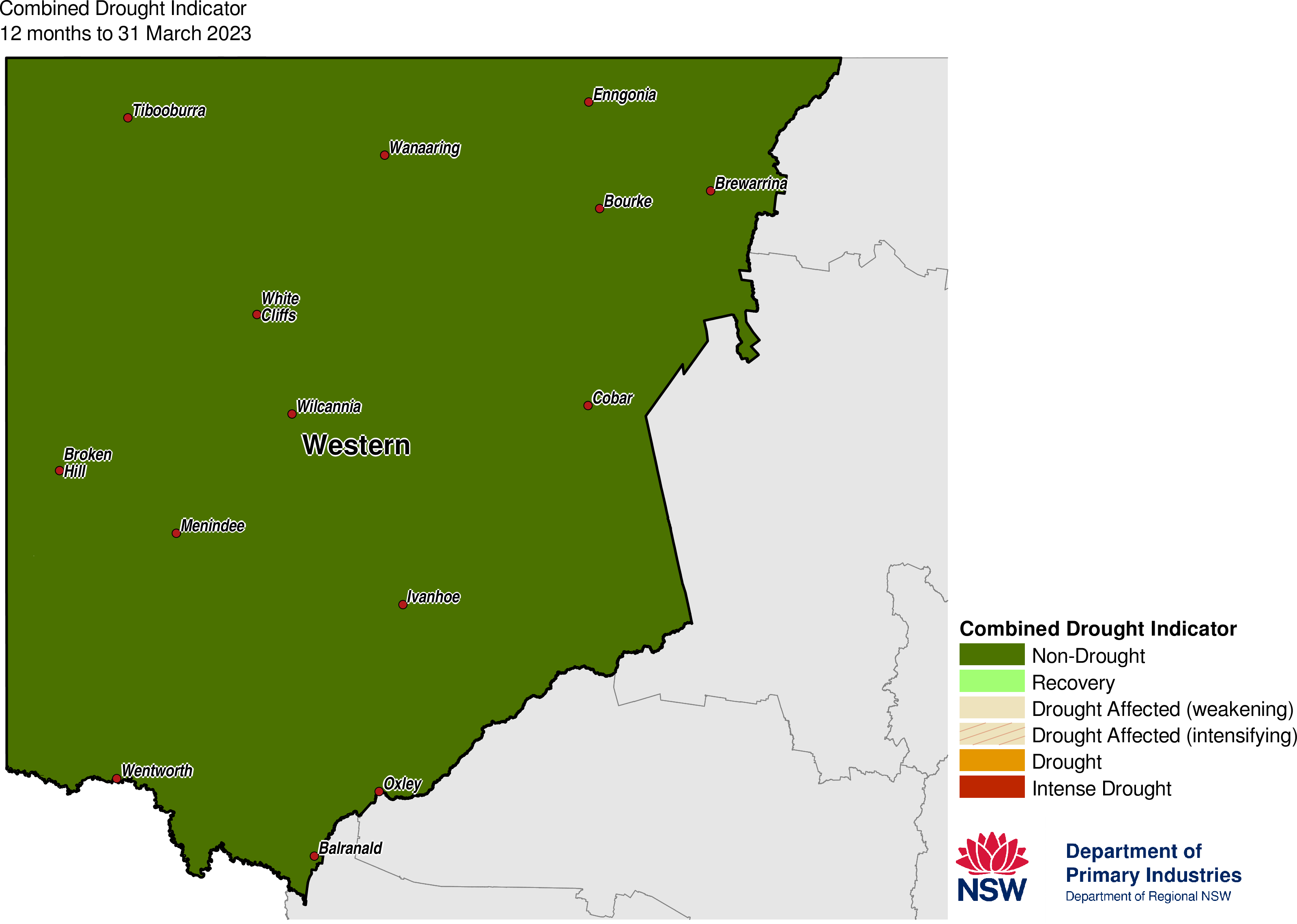
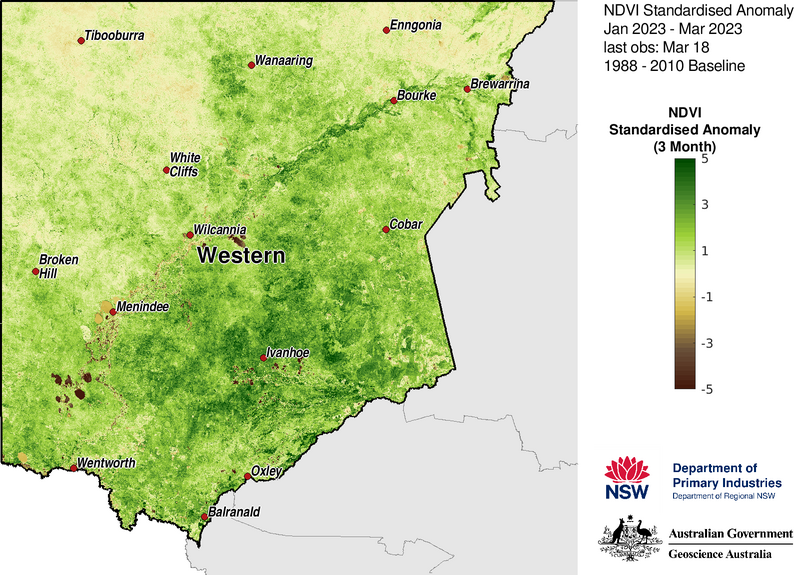
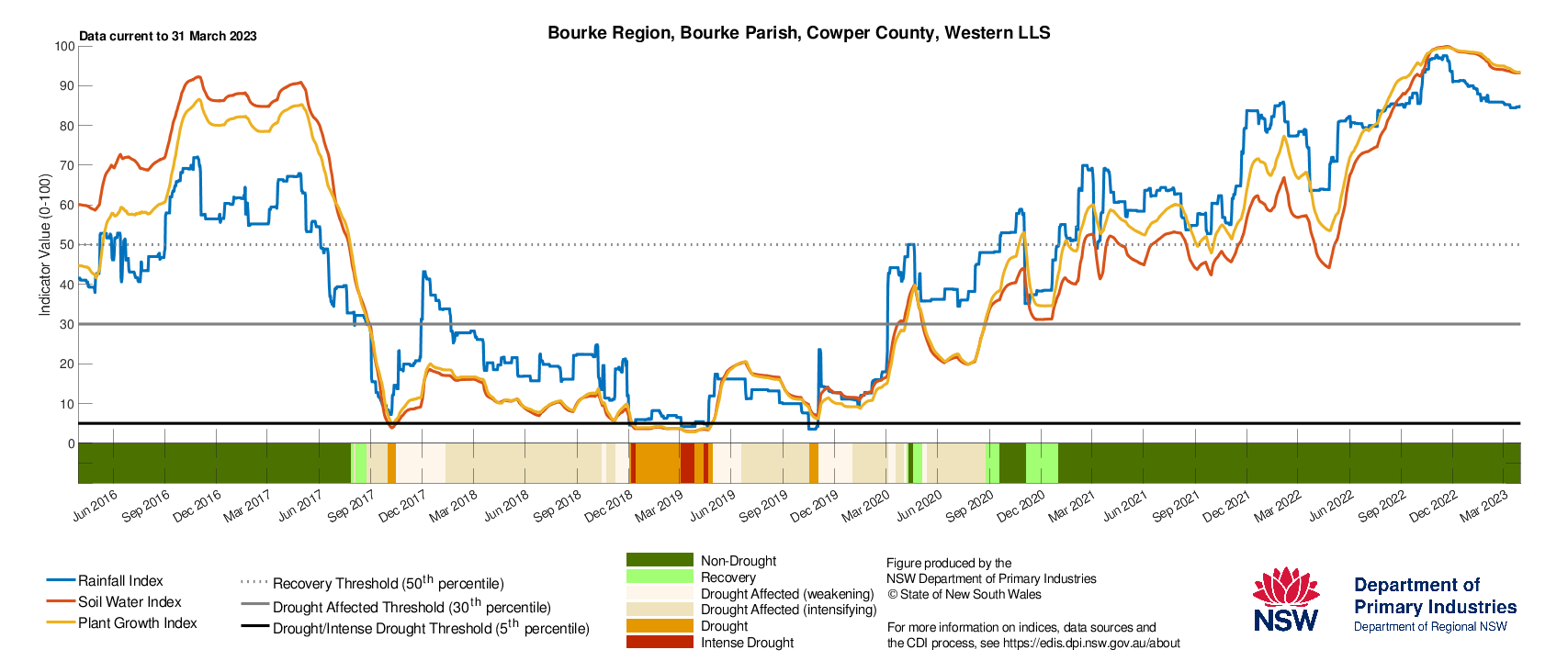
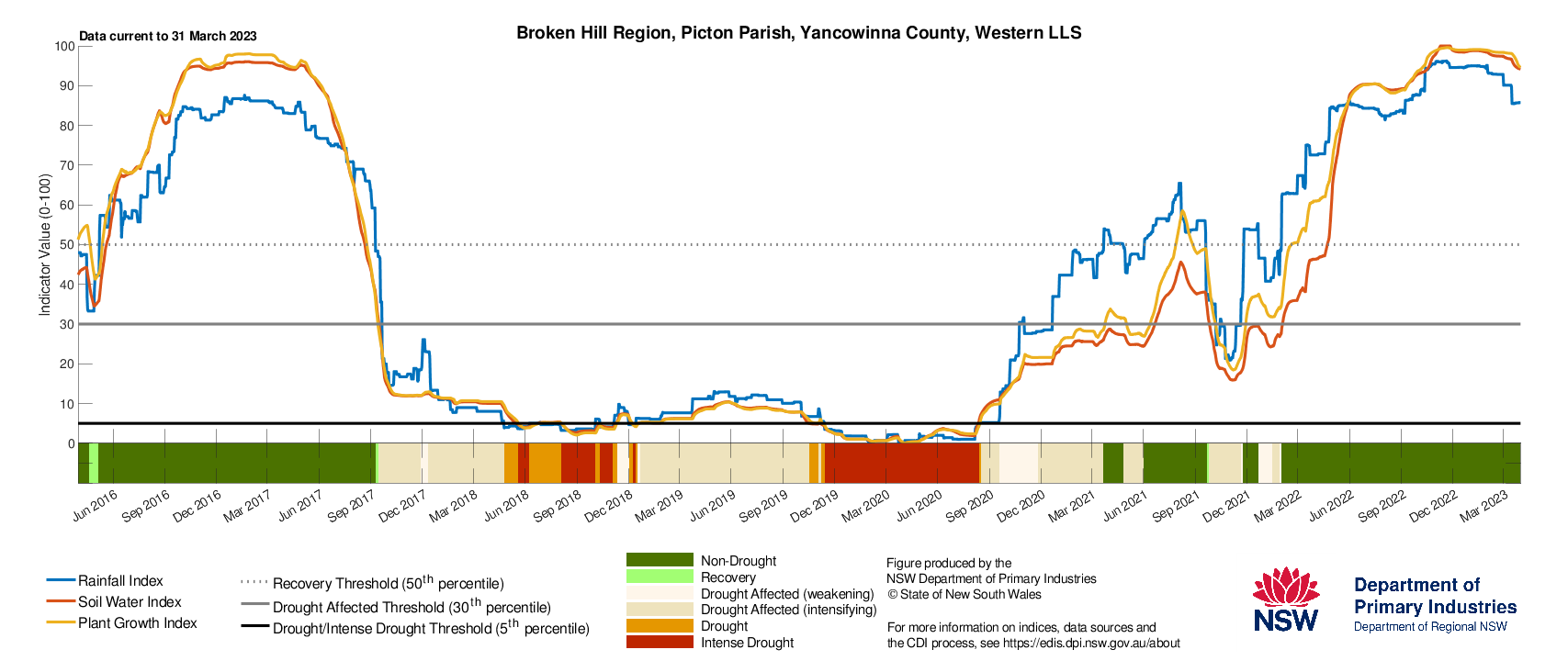
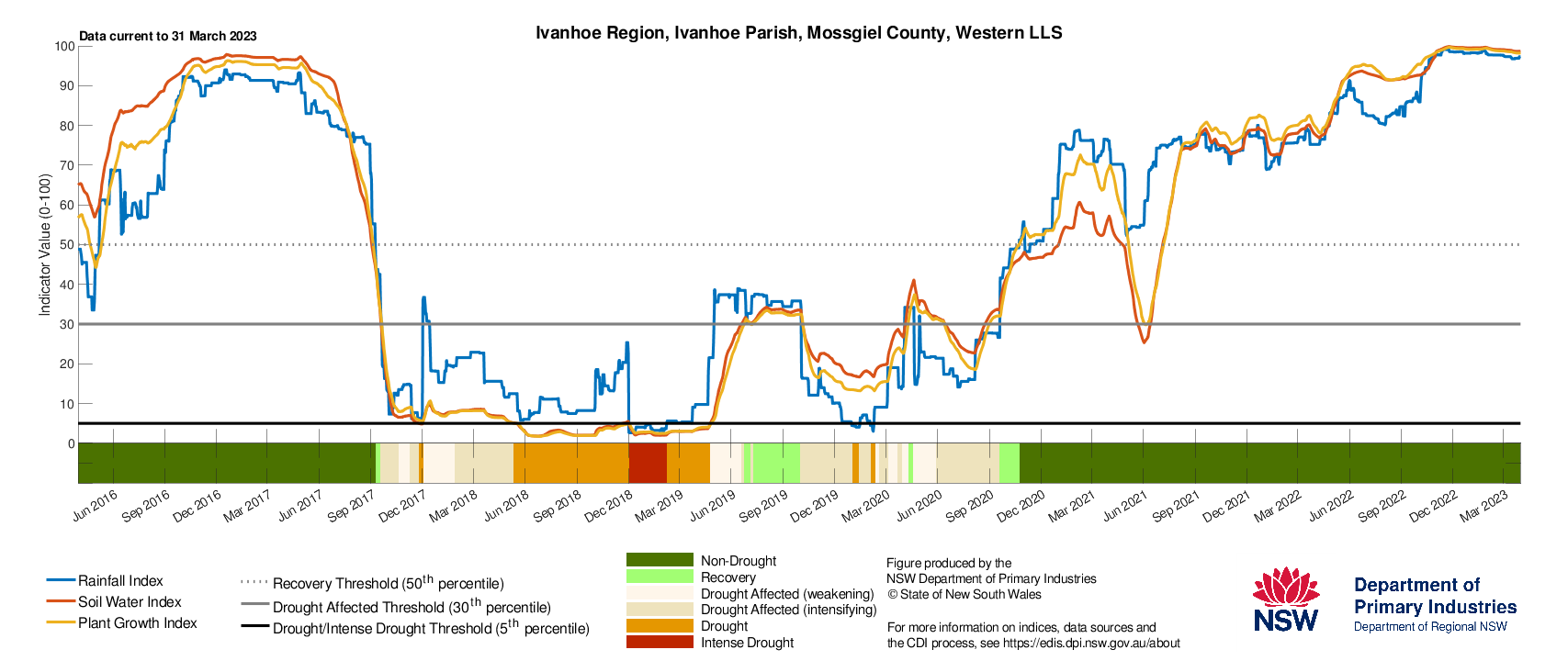
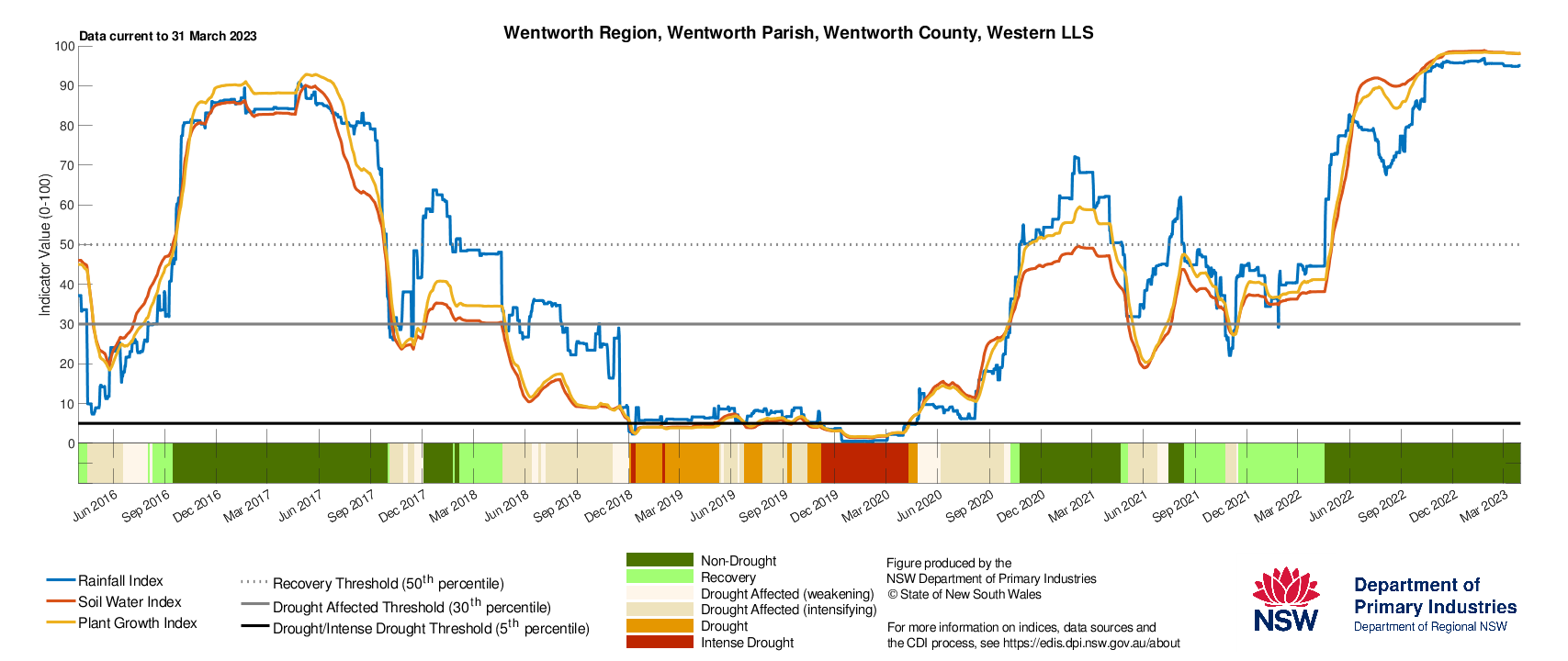
North West, Northern Tablelands and North Coast regions
The Combined Drought Indicator (CDI, Figure 24) shows that the North West, Northern Tablelands and North Coast Local Land Services regions are in the Non-Drought category.
The seasonal NDVI anomaly data (Figure 25) indicates near normal levels of greenness across the North Coast LLS region for the January to March period. Parts of the Northern Tablelands and North West LLS regions, around Inverell, Armidale, and Tamworth have average to below average levels of greenness. Some of the extremely negative NDVI areas (brown patches) represent water. The NSW DPI continues to closely monitor conditions in these regions.
There are reports that planning for winter cropping is underway in the North West and Northern Tablelands LLS regions after widespread recent rainfalls.
The Drought History charts (Figure 26) show the individual response of the drought indicators for Tenterfield, Moree, Walgett, and Lismore. All indicators remain high at Moree. Indicators have declined at Tenterfield and Lismore, and the Rainfall indicator has declined at Walgett. These declines are likely due to below average rainfall received in the first three months of 2023. Further rainfall is required to maintain productive conditions. These regions should continue monitor conditions closely. To access a Drought History chart for your Parish, visit the Seasonal Conditions Information Portal.
The Combined Drought Indicator (CDI) is a tool that monitors drought conditions across NSW. The drought categories are based on assessing the response of three drought indicators: soil water, plant growth and rainfall. The indicators track the data over the past 12 months and shows how the indices are tracking compared to the long-term averages. The information provided in the map is aggregated to a Parish level and provides a regional assessment of conditions. Variability within and between farms is possible and this may not be reflected in the CDI map.
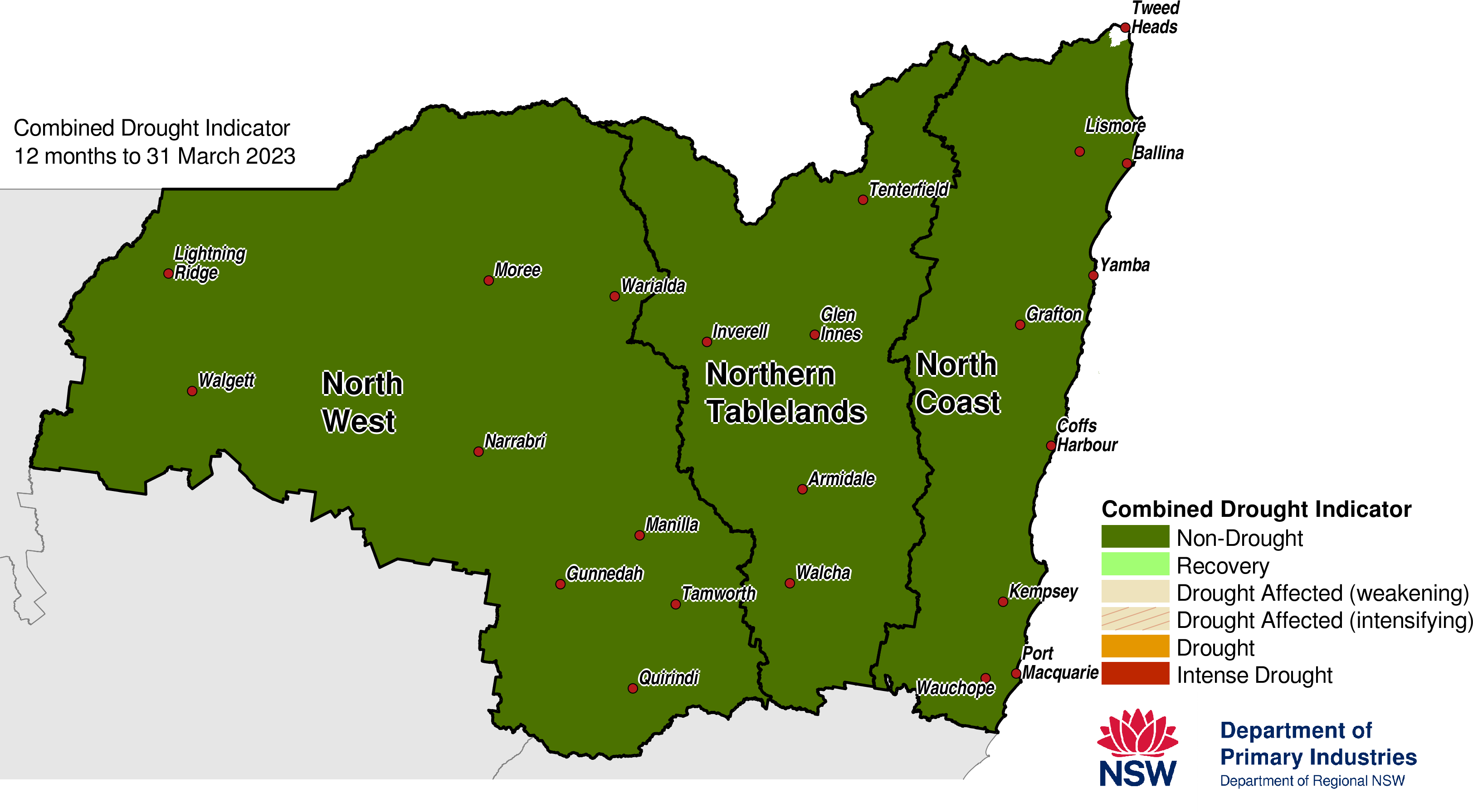
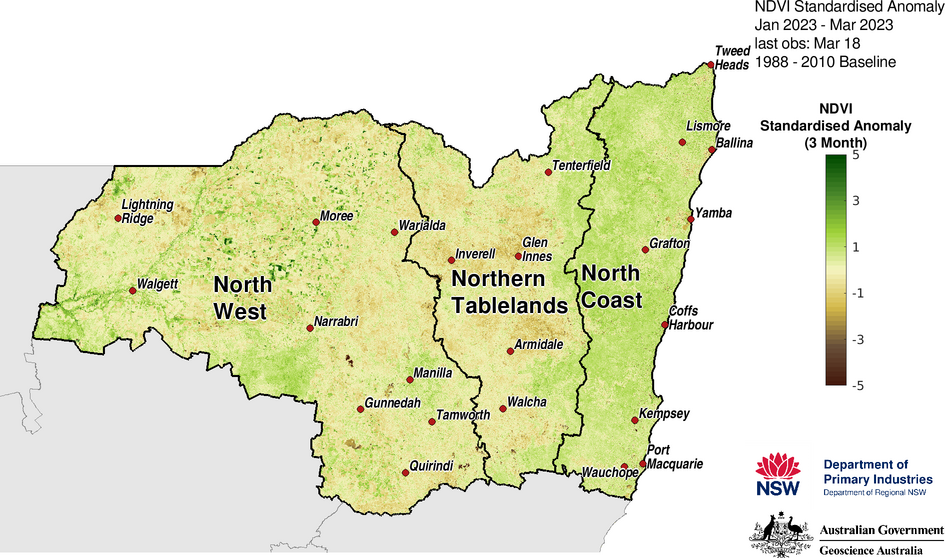
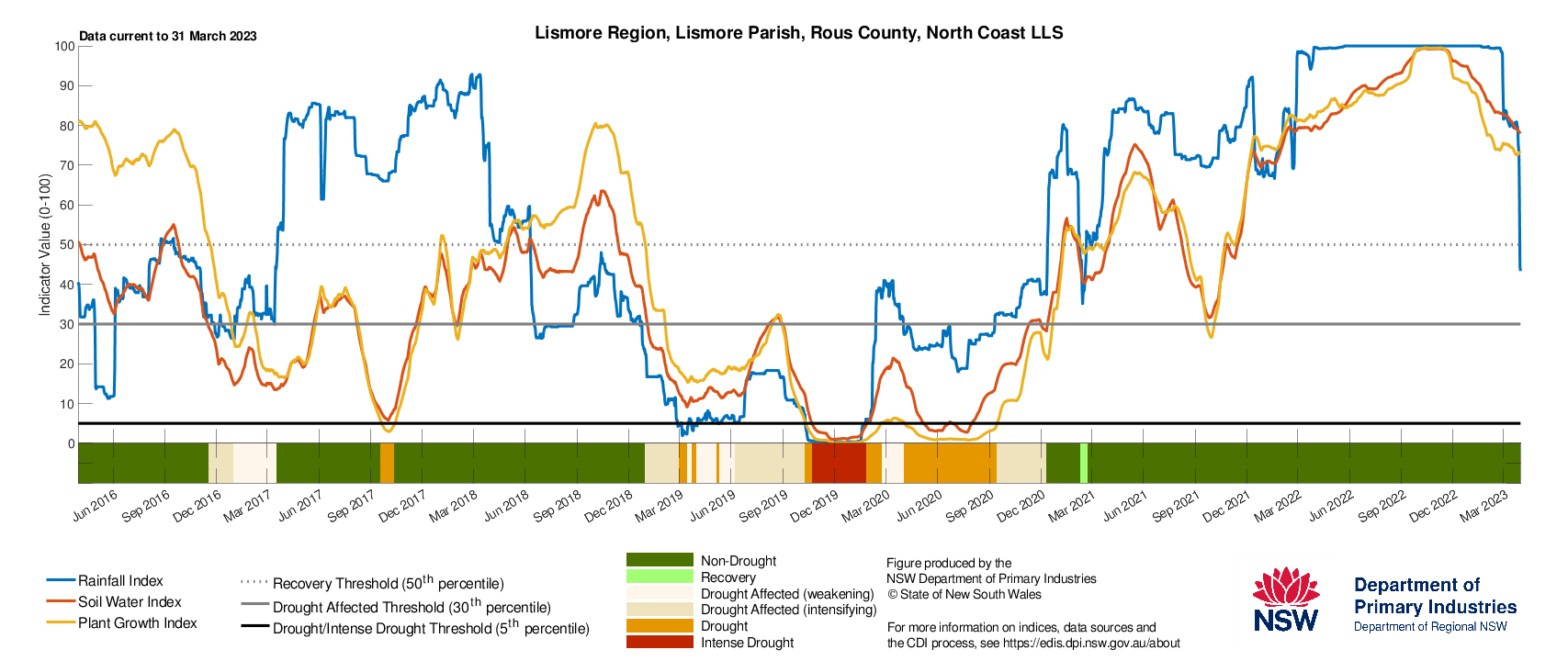
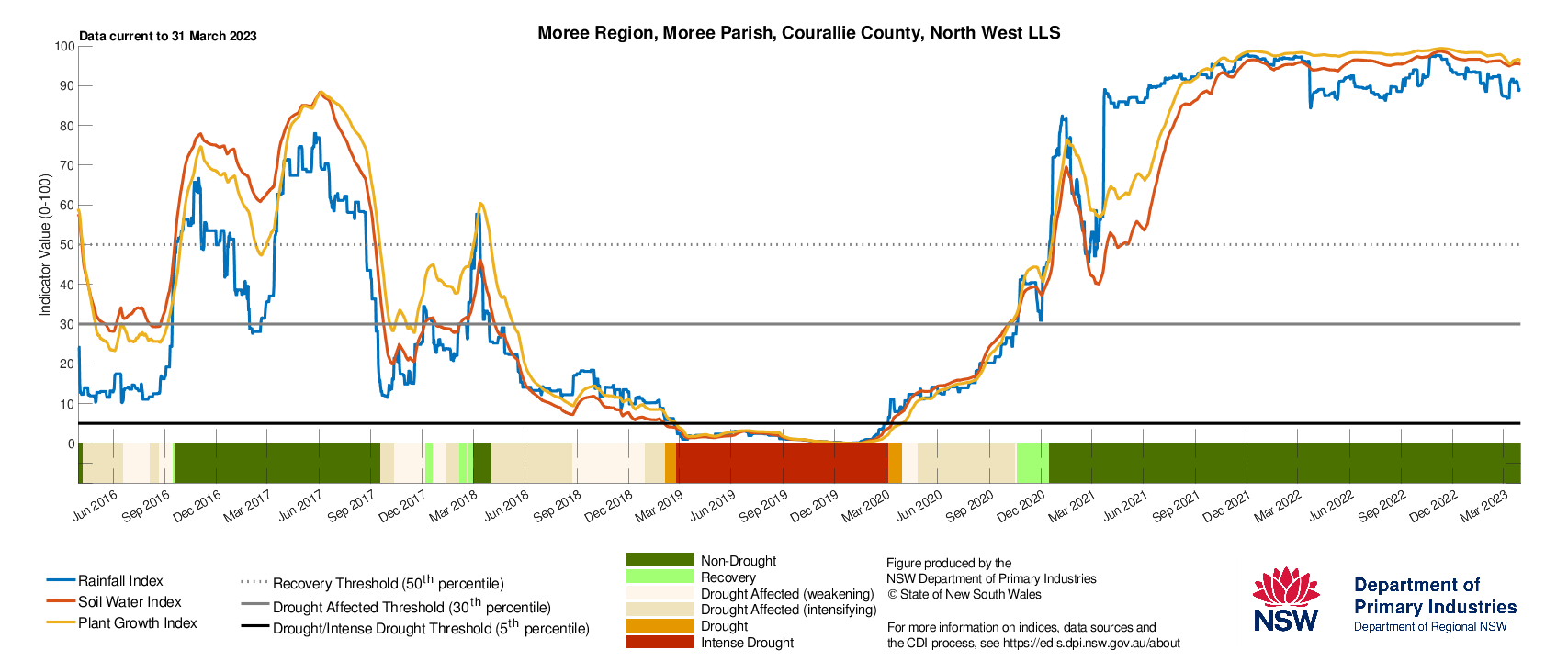
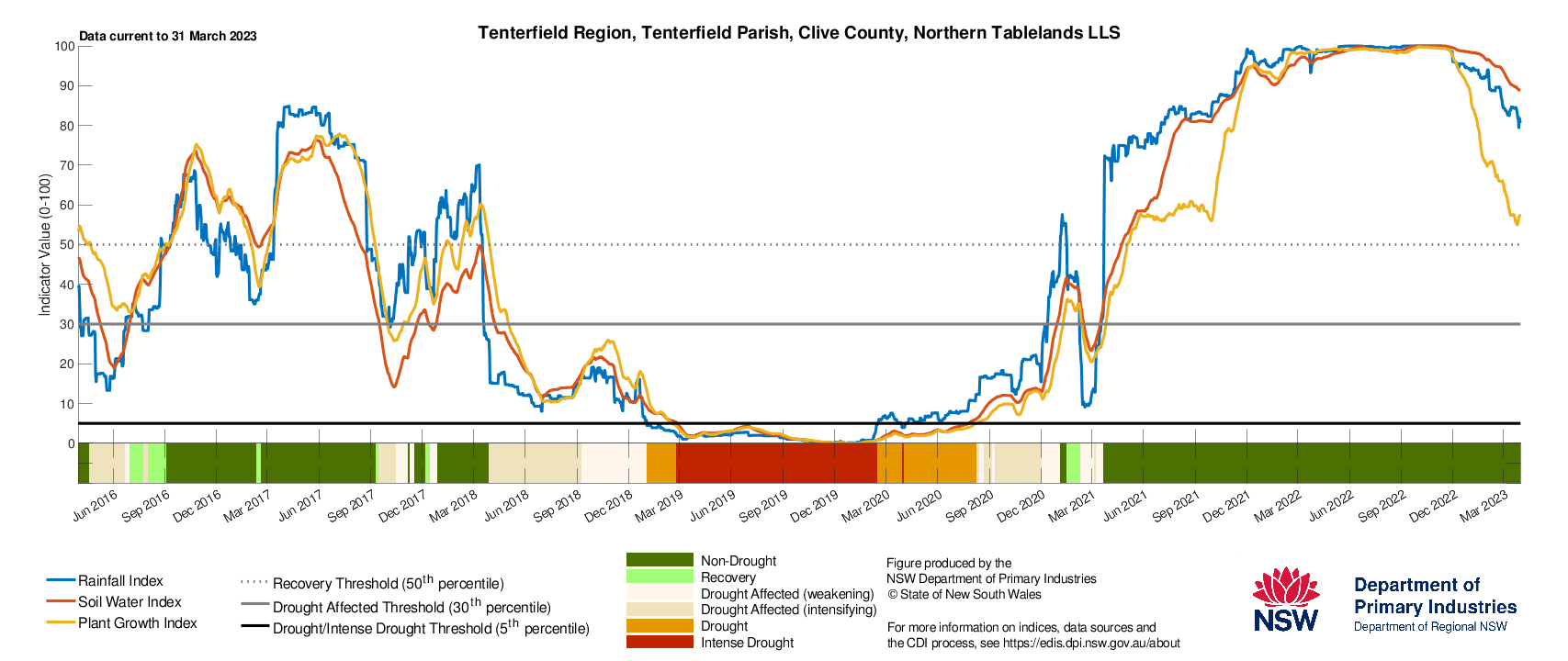
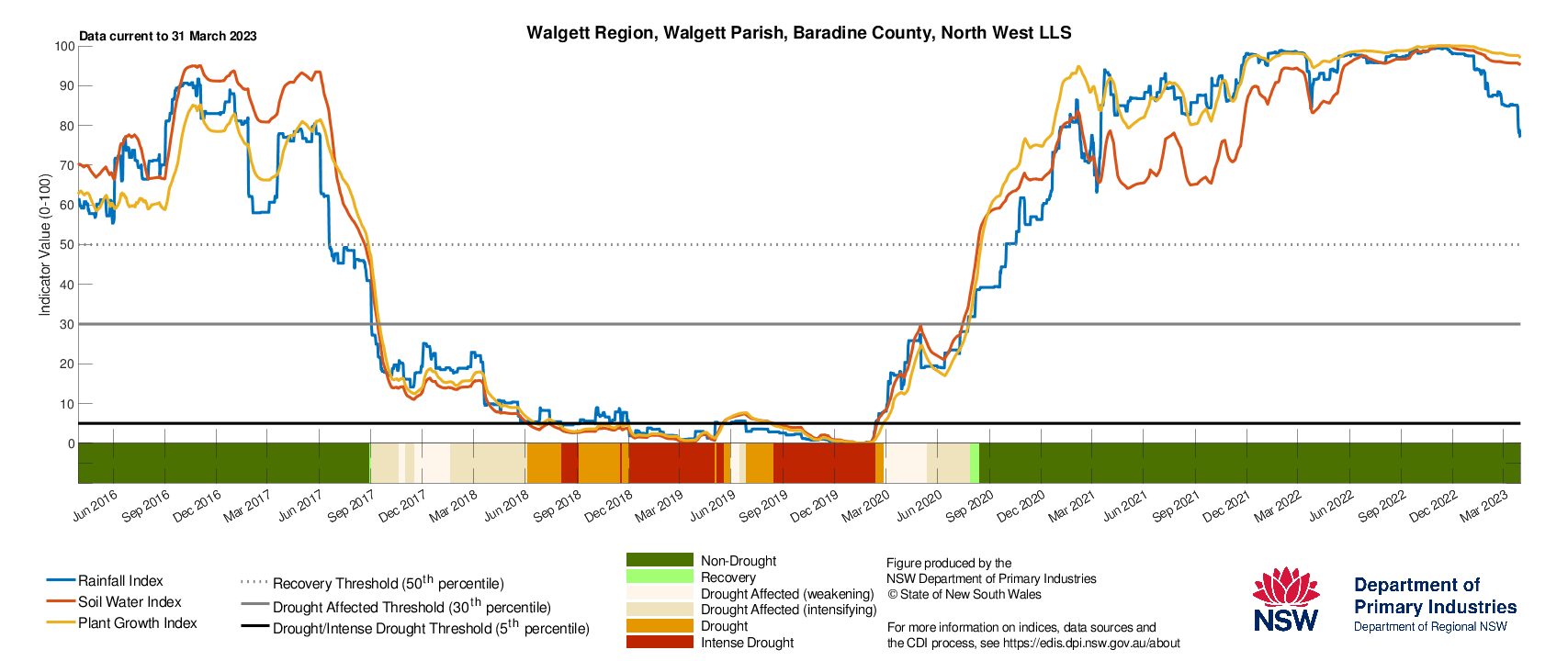
Central Tablelands, Central West, Hunter and Greater Sydney regions
The Combined Drought Indicator (CDI; Figure 27) shows that the Central West, Central Tablelands, Hunter and Greater Sydney Local Land Services (LLS) regions continue to experience Non-Drought conditions at the end of March.
The seasonal NDVI anomaly data (Figure 25) indicates near normal levels of greenness across parts of the regions for the January to March period. Parts of the Central West and Hunter LLS regions, around Coonamble, Coonabarabran, and Merriwa have average to below average levels of greenness. Some of the extremely negative NDVI areas (brown patches) represent water. The NSW DPI continues to closely monitor conditions in these regions.
The Drought History charts (Figure 29) show the individual response of the drought indicators for Cowra, Condobolin and Singleton. There has been a decline in the CDI indicators at Singleton however, the CDI indicators are currently high at all locations. To access a Drought History chart for your Parish, visit the Seasonal Conditions Information Portal.
The CDI is a tool that monitors drought conditions across NSW. The drought categories are based on assessing the response of three drought indicators: soil water, plant growth and rainfall. The indicators track the data over the past 12 months and show how the indices are tracking compared to the long-term averages. The information provided in the map is aggregated to a Parish level and provides a regional assessment of conditions. Variability within and between farms is possible and this may not be reflected in the CDI map.
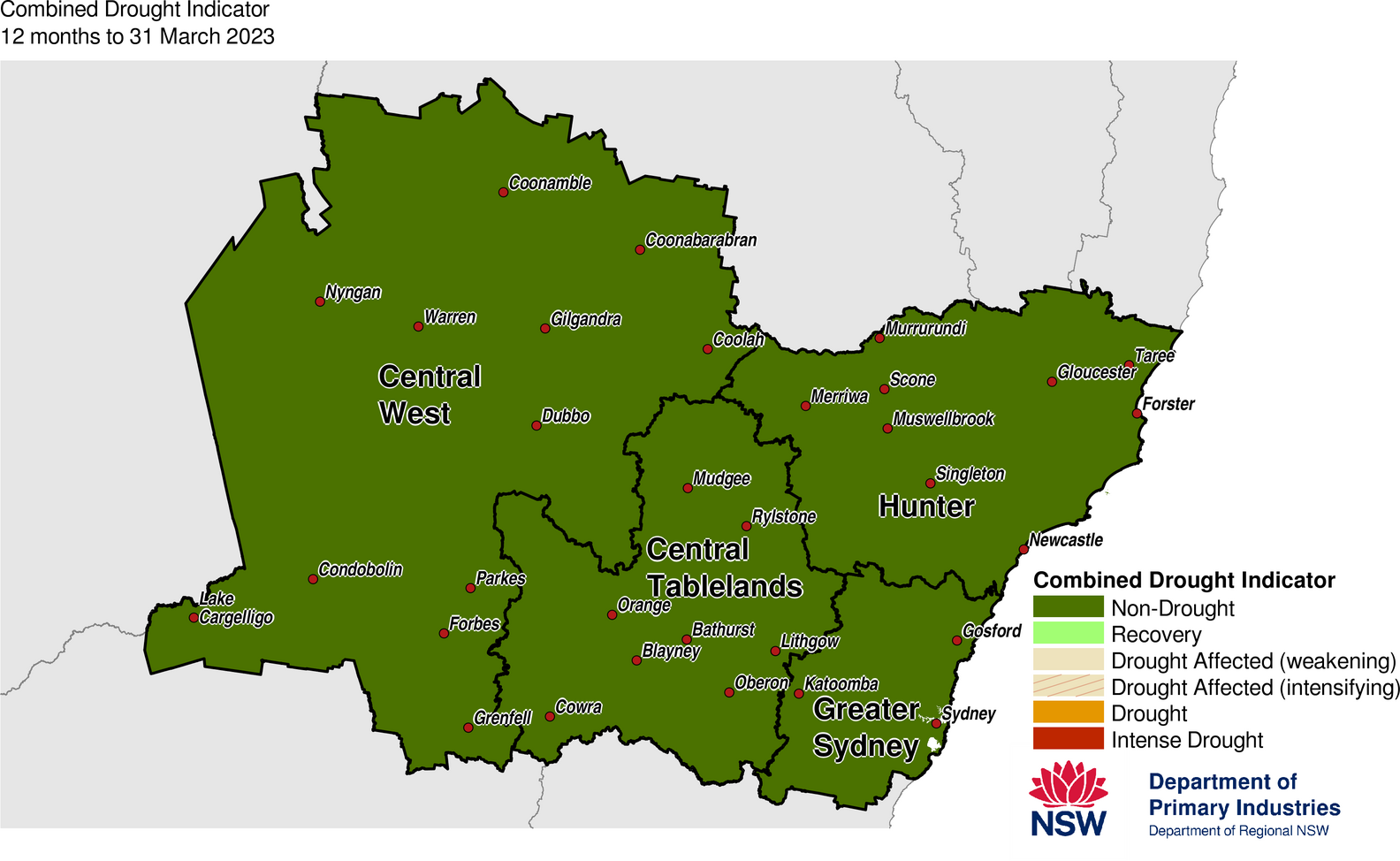
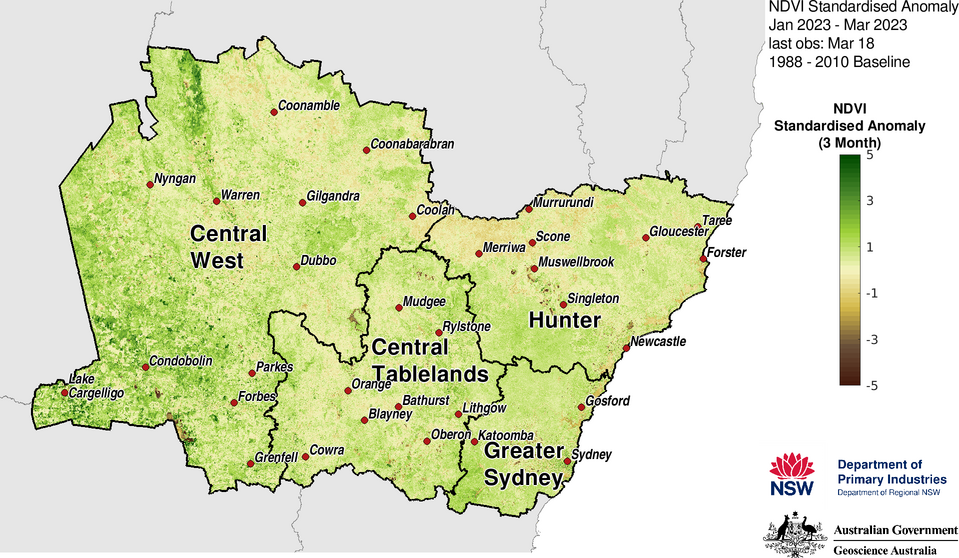
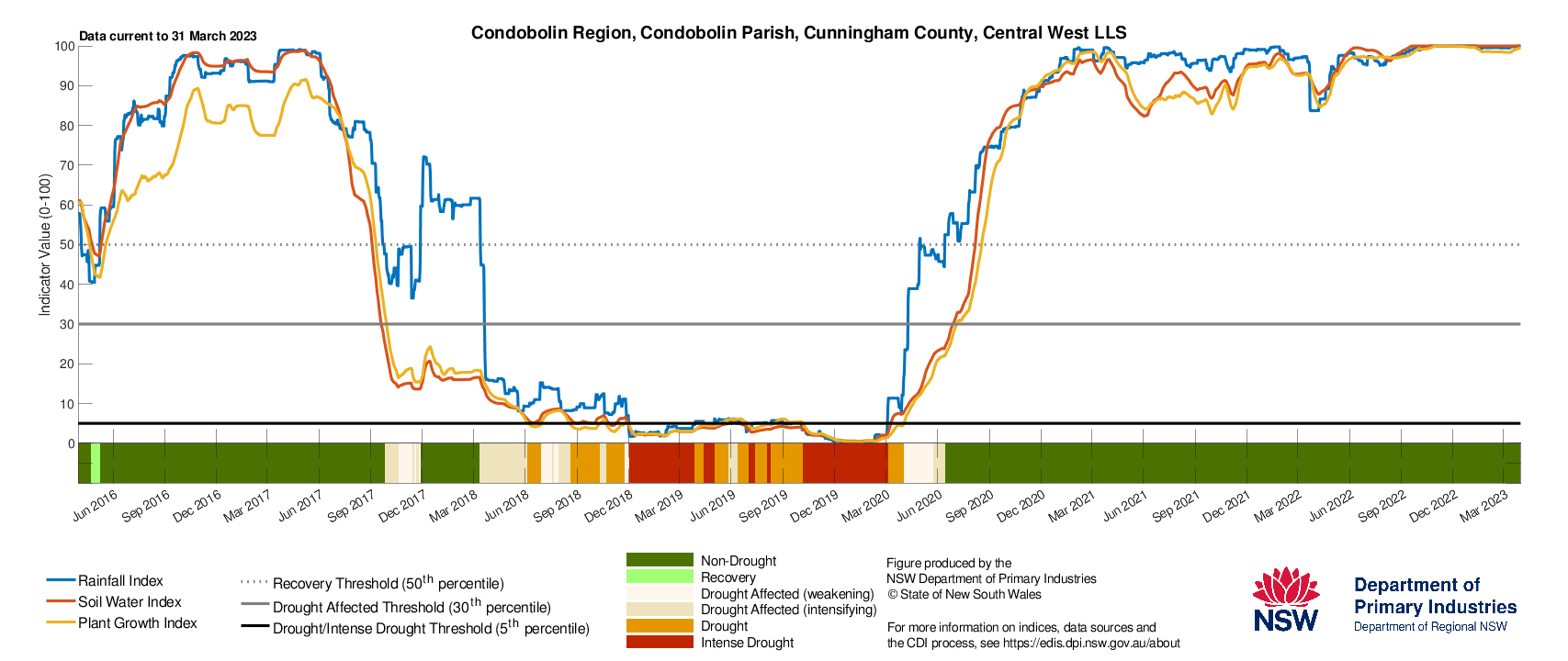
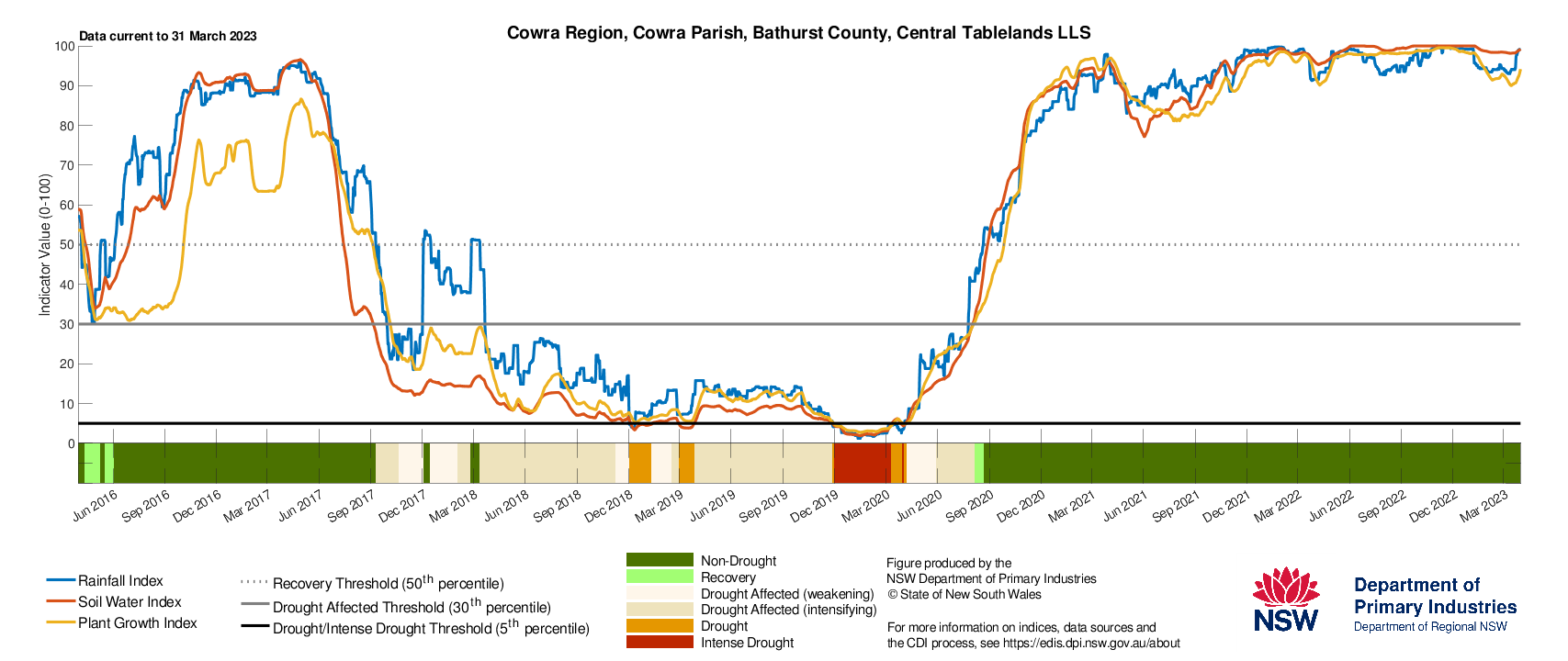
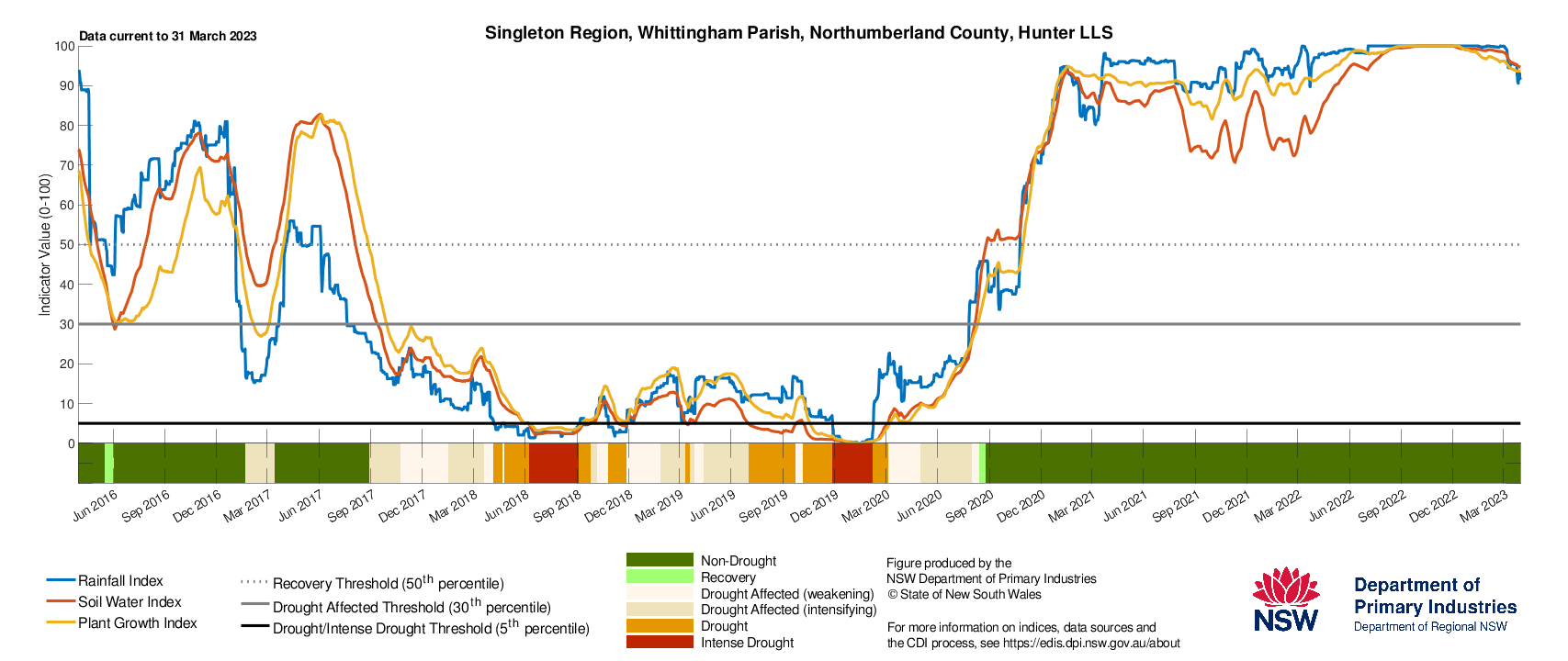
South East region
The Combined Drought Indicator (CDI, Figure 30) shows that the South East Local Land Services region is in the Non-Drought CDI category.
The seasonal NDVI anomaly data (Figure 31) shows near normal to above average levels of plant greenness. Some of the extremely negative NDVI areas (brown patches) represent water.
The Drought History charts (Figure 32) show the individual response of the drought indicators at Bega, Cooma and Goulburn. Indicators have declined at all locations and there has been a large decline in the Rainfall indicator at Bega since the last Update. Recent rainfallshave has provided a small increase in the Rainfall indicators and further rainfall is required to maintain the pasture and soil water indicators. The NSW DPI continues to closely monitor conditions in these regions. To access a Drought History chart for your Parish, visit the Seasonal Conditions Information Portal.
The Combined Drought Indicator (CDI) is a tool that monitors drought conditions across NSW. The drought categories are based on assessing the response of three drought indicators: soil water, plant growth and rainfall. The indicators track the data over the past 12 months and shows how the indices are tracking compared to the long-term averages. The information provided in the map is aggregated to a Parish level and provides a regional assessment of conditions. Variability within and between farms is possible and this may not be reflected in the CDI map.
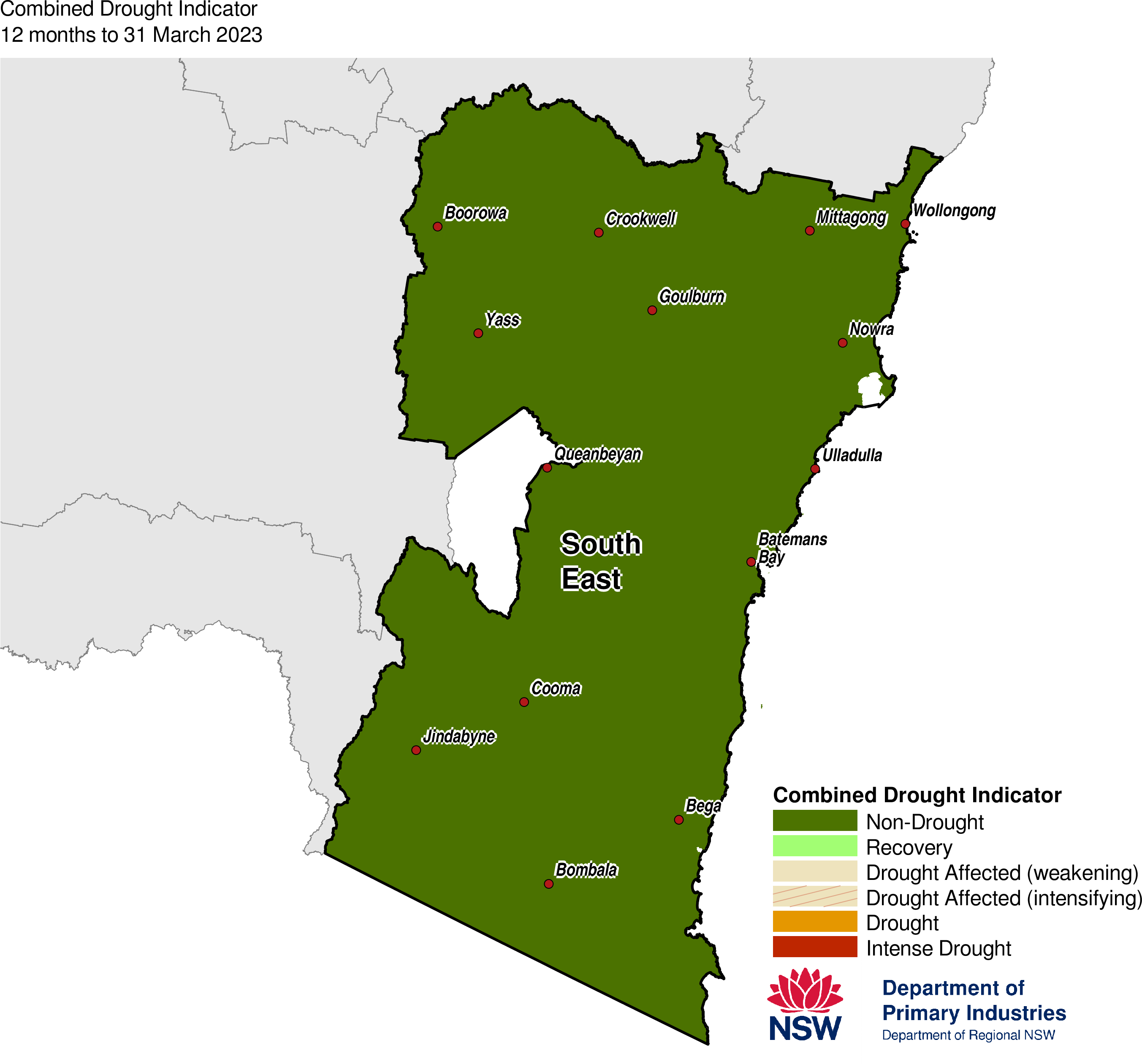
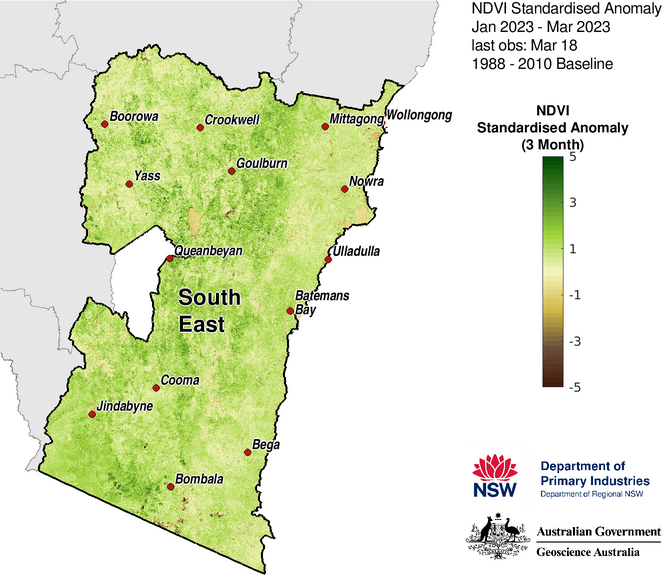
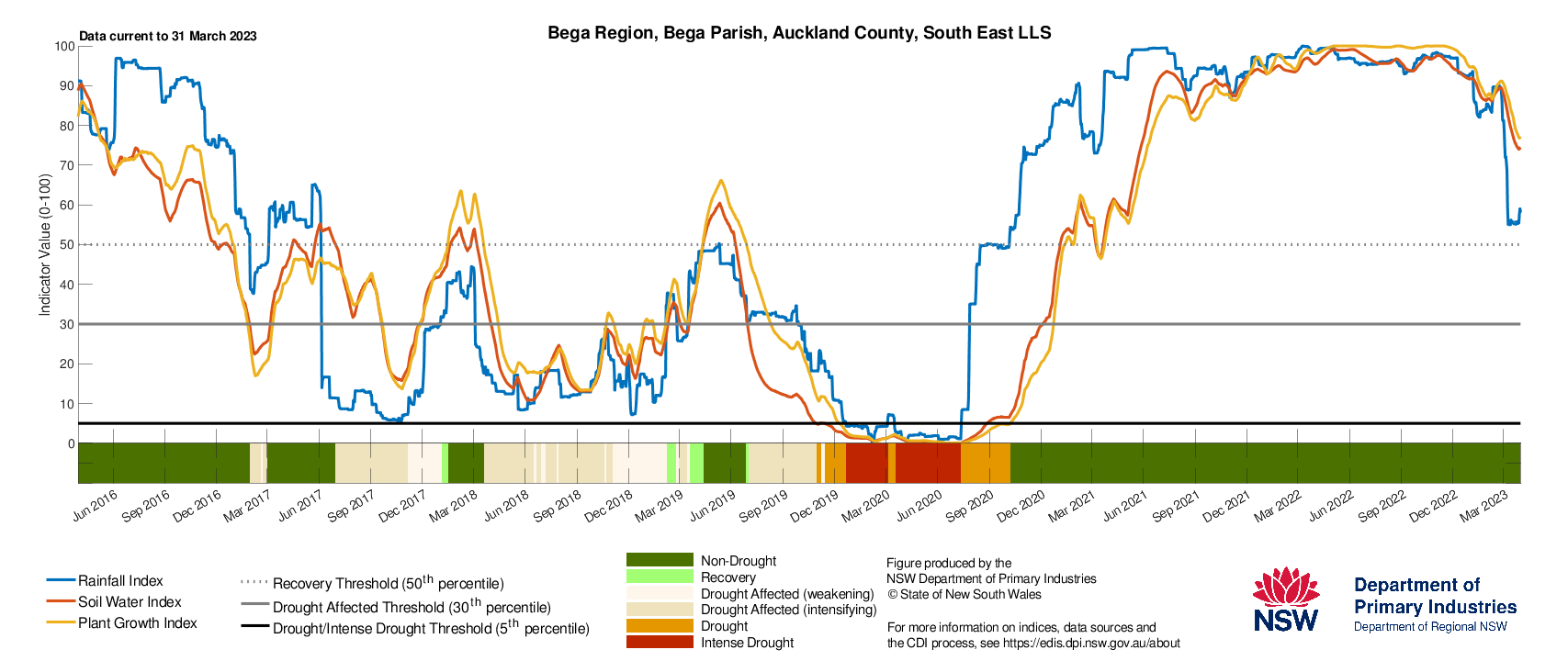
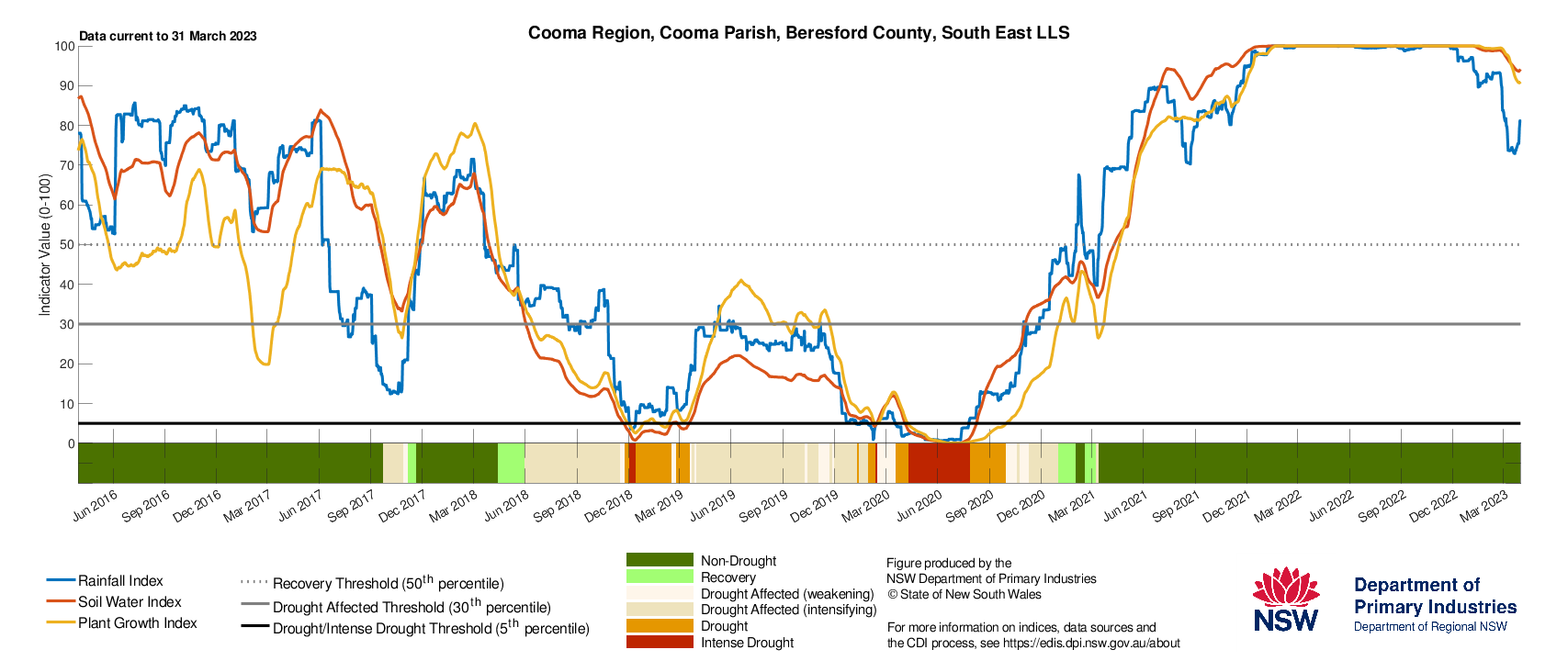
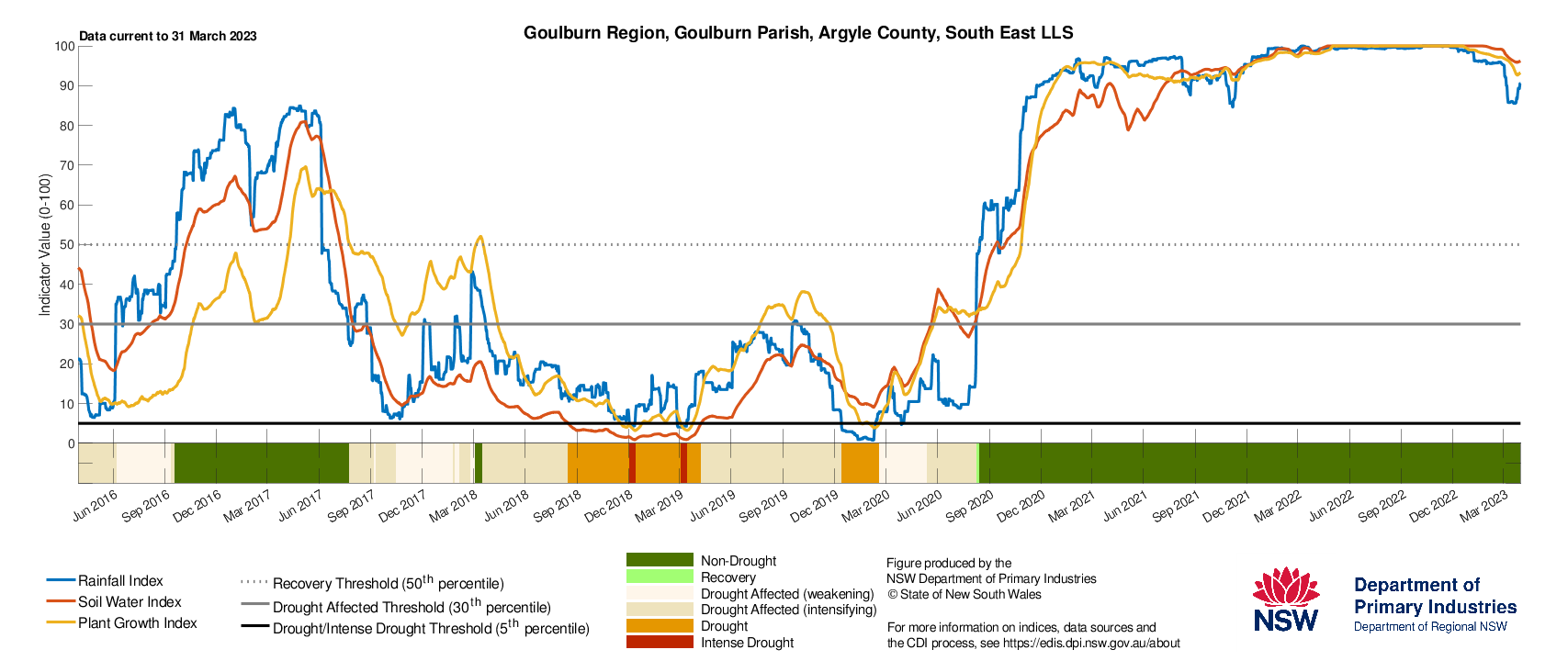
How does it work?

Much of the information in the Seasonal Conditions Report is sourced from the NSW DPI Enhanced Drought Information System (EDIS)™. The EDIS system is currently available in prototype form and is subject to an intensive ground truthing process. For more information, visit the interactive website via droughthub.nsw.gov.au.
EDIS is an ongoing project aimed at improving the quality and timeliness of efforts to monitor conditions across the state. Key features of the system are:
- It tracks drought by using four indicators; rainfall, soil water, plant growth, as well as tracing rainfall trends. Agronomic conditions have equal value to rainfall recorded at meteorological stations.
- The Combined Drought Indicator (CDI) brings this information together and has been designed to characterise developing drought conditions. The key purpose for building the CDI was as a drought early warning system.
- The rainfall, soil moisture and plant growth indicators in EDIS account for conditions over a 12-month window. This provides a compromise between a highly sensitive indicator (e.g. six months) and a less sensitive indicator (e.g. 24 months).
- Climate and remote sensing data drive the information system at a high resolution, but the CDI is reported at a Parish level.
- Because of its configuration and purpose, there will be differences to the indicator used in the National Drought Monitoring Framework (the Australian Rainfall Deficiency Analyser) which relies on rainfall alone.
- The CDI has three drought categories that characterise NSW according to drought intensity as well as the main drivers of a drought event (meteorological, hydrological and agronomic). DPI considers areas Drought Affected to be experiencing a drought event.
- The Drought Affected category encompasses a wide range of conditions from the very early stages of drought entry through to a drought event becoming intense. This enables the drought monitoring system to detect a drought event early. It is also possible to stay in the Drought Affected category for some period of time.
The way in which the indicators are combined to form the CDI is described in Table 1 below.
Table 1: Description of the Combined Drought Indicator framework
CDI Phase | Technical definition | Description - typical field conditions |
|---|---|---|
Intense Drought | All three indicators (rainfall, soil water, plant growth) are below the 5th percentile | Ground cover is very low, soil moisture stores are exhausted and rainfall has been minimal over the past 6-12 months. |
Drought | At least one indicator is below the 5th percentile | Conditions may be very dry, or agronomic production is tight (low soil moisture or plant growth). It is possible to be in Drought when there has been some modest growth, or a few falls of rain. |
Drought Affected (intensifying) | At least one indicator is below the 30th percentile and the rainfall trend is negative over the past 90 days. | Conditions are deteriorating; production is beginning to get tighter. Ground cover may be modest, but growth is moderate to low for the time of year. When indicators are close to the Drought threshold drought conditions are severe. |
Drought Affected (weakening) | At least one indicator is below the 30th percentile and the rainfall trend is positive over the past 90 days. | Production conditions are getting tighter, but there have been some falls of rain over the past month. It is rare to enter the Recovering phase from the Non-Drought category; Usually there is a quick (1-2 week) transition into Drought Affected or Drought. When indicators are close to the Drought threshold drought conditions are severe. |
Recovering | All indicators are below the 50th percentile but above the 30th percentile | Production is occurring but would be considered ‘below average’. Full production recovery may not have occurred if this area has experienced drought conditions over the past six months. |
Non-drought | At least one indicator is above the 50th percentile. | Production is not limited by climatic conditions. |
The NSW State Seasonal Update is provided each month by the NSW DPI Climate Branch.
Information used in this report was primarily sourced from the Australian National University, Australian Bureau of Meteorology, the US National Oceanic and Atmospheric Administration, the International Research Institute for Climate and Society (Columbia University), Geoscience Australia’s Digital Earth Australia Program, and NSW Department of Primary Industries.
Maps in this document contain data which is © Spatial Services – NSW Department of Finance, Services and Innovation (2022), Panorama Avenue, Bathurst 2795 and data which is © Commonwealth of Australia 2022, Australian Bureau of Meteorology, Melbourne, and © Australian National University. All rights reserved.
The seasonal outlooks presented in this report are obtained from the Australian Bureau of Meteorology and other sources (including World Meteorological Organisation Global Producing Centres). These outlooks are general statements about the likelihood (chance) of (for example) exceeding the median rainfall or minimum or maximum temperatures. Such probability outlooks should not be used as categorical or definitive forecasts but should be regarded as tools to assist in risk management and decision making. Changes in seasonal outlooks may have occurred since this report was released.
All climate and remote sensing input data is supplied to the Enhanced Drought Information System™ under the Australian Creative Commons Licence (CCY 4.0) and is made available by the Terrestrial Ecosystem Research Network.
© State of New South Wales through the Department of Regional NSW, 2023. You may copy, distribute and otherwise freely deal with this publication for any purpose, provided that you attribute the NSW Department of Primary Industries as the owner.
Disclaimer: The information contained in this publication is based on knowledge and understanding at the time of writing (April 2023). However, because of advances in knowledge, users are reminded of the need to ensure that information upon which they rely is up to date and to check currency of the information with the appropriate officer of the Department of Primary Industries or the user’s independent adviser.
Published by the NSW Department of Primary Industries. ISSN 2202-1795 (Online). Volume 11 Issue 3.

